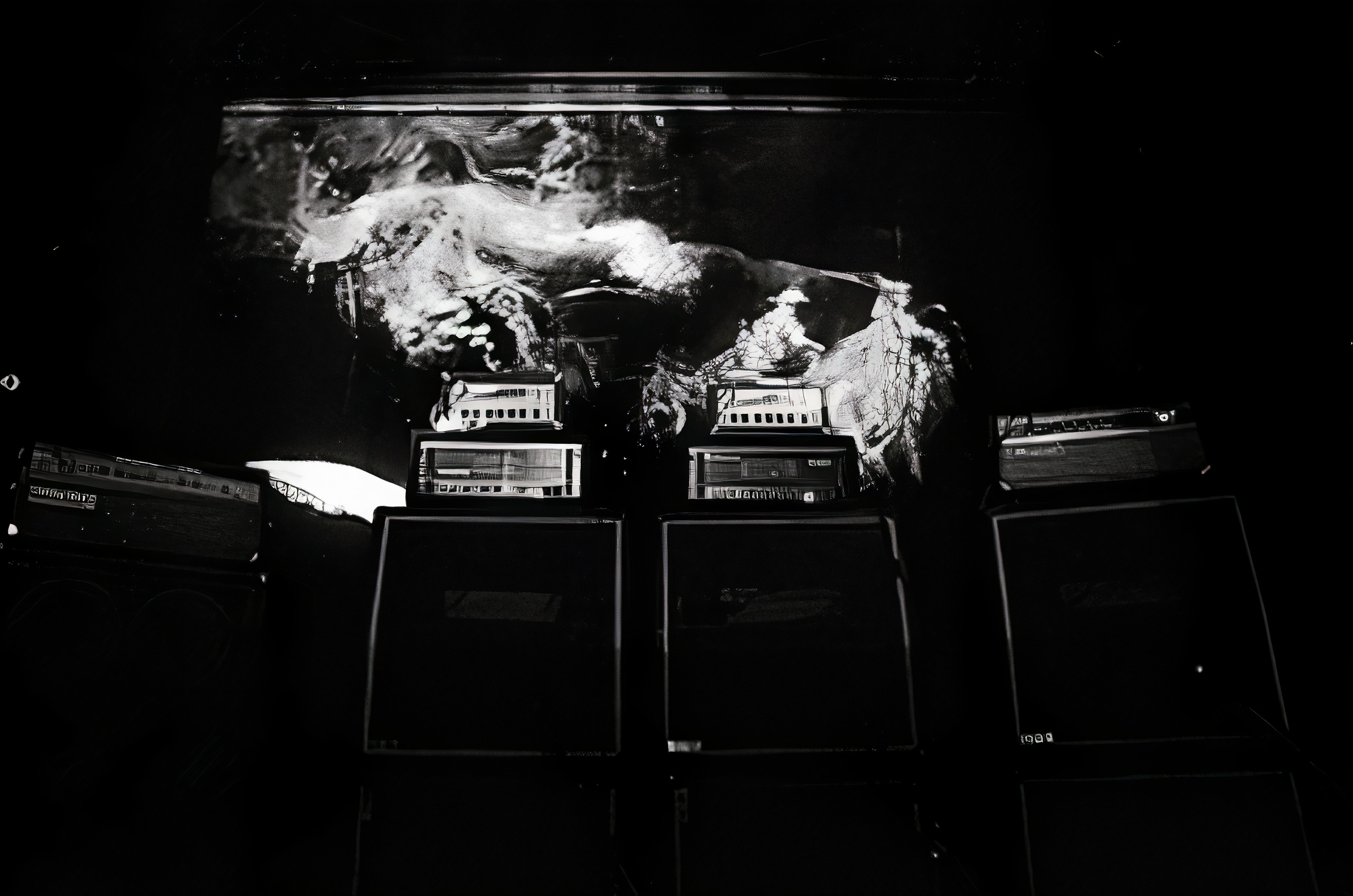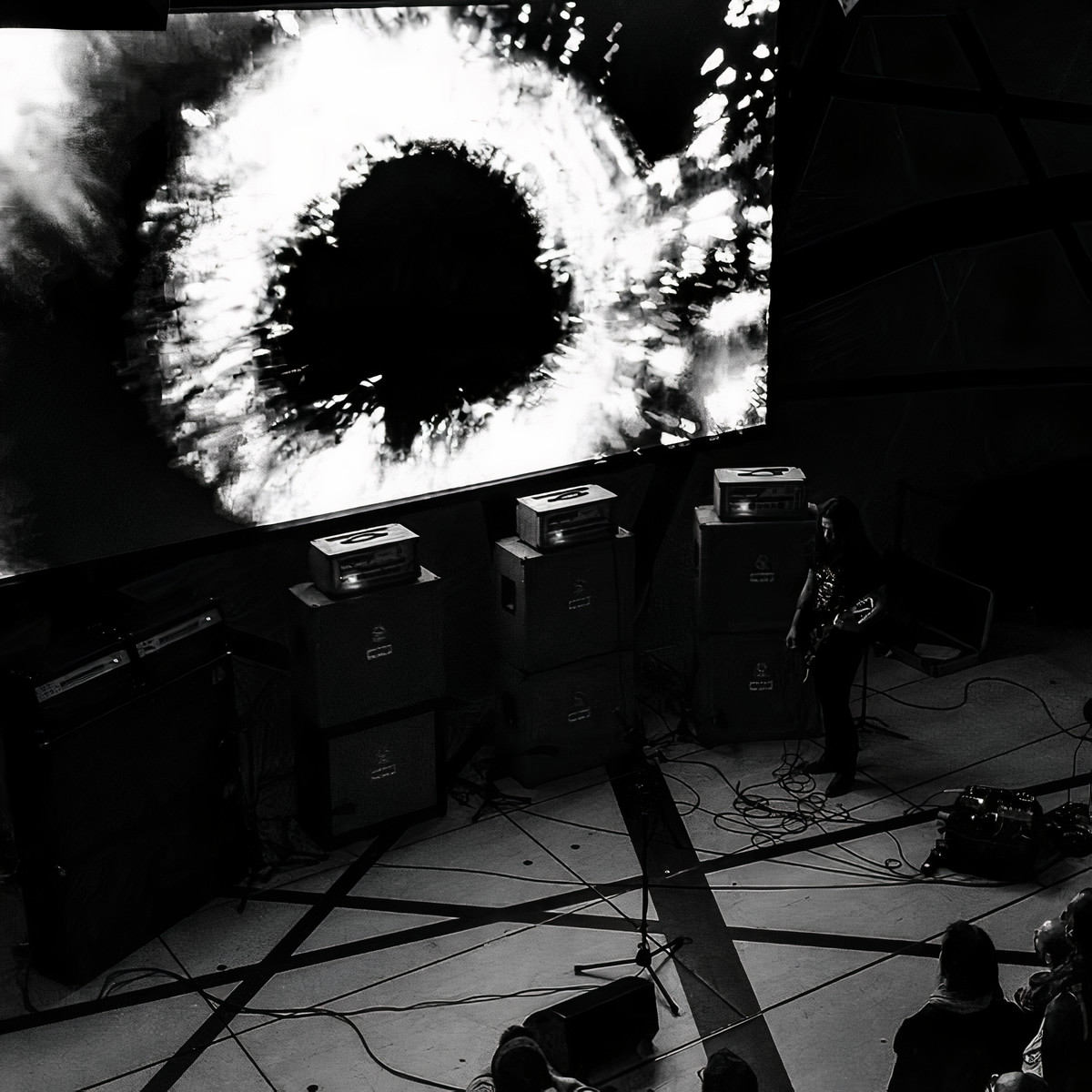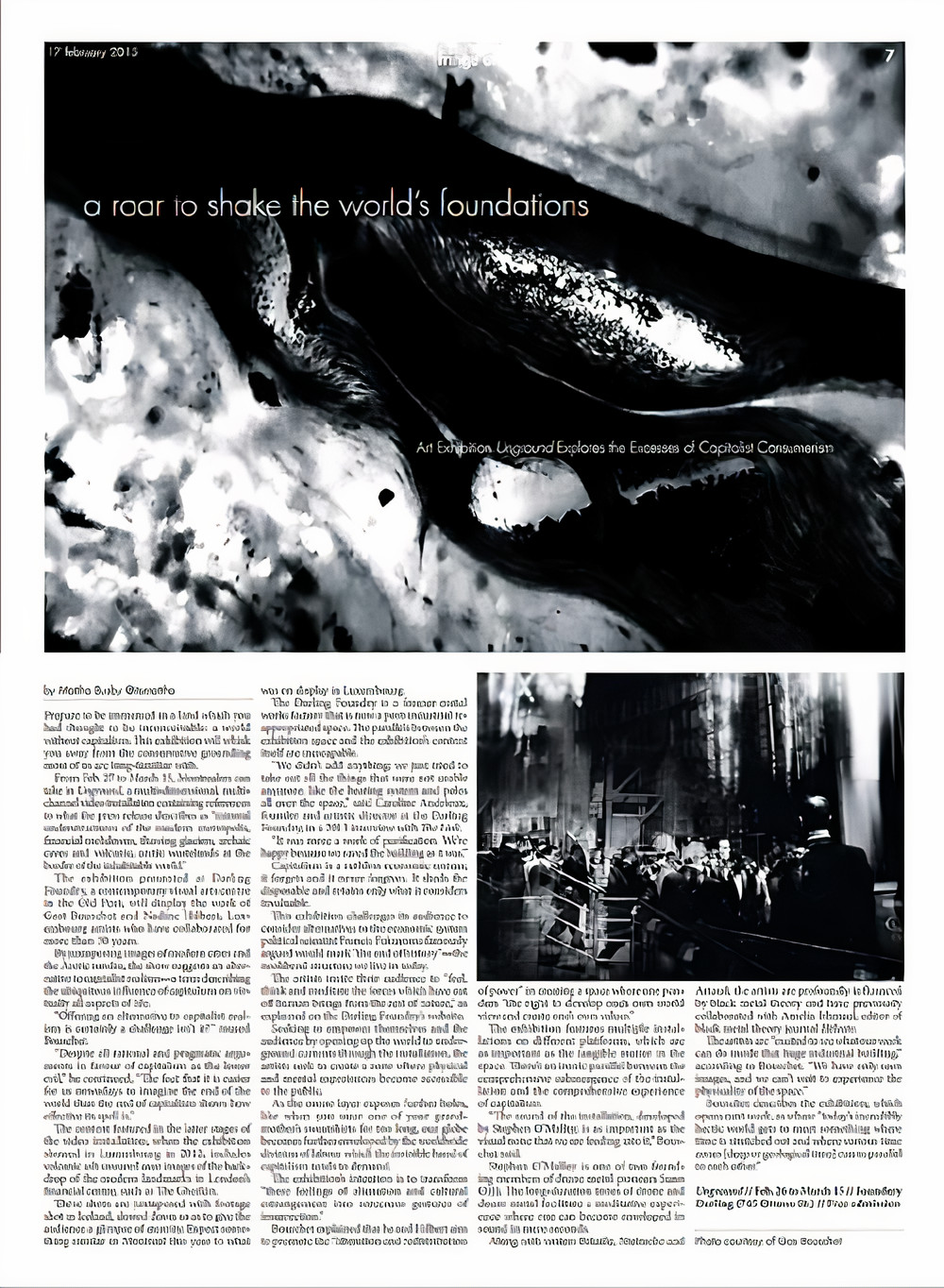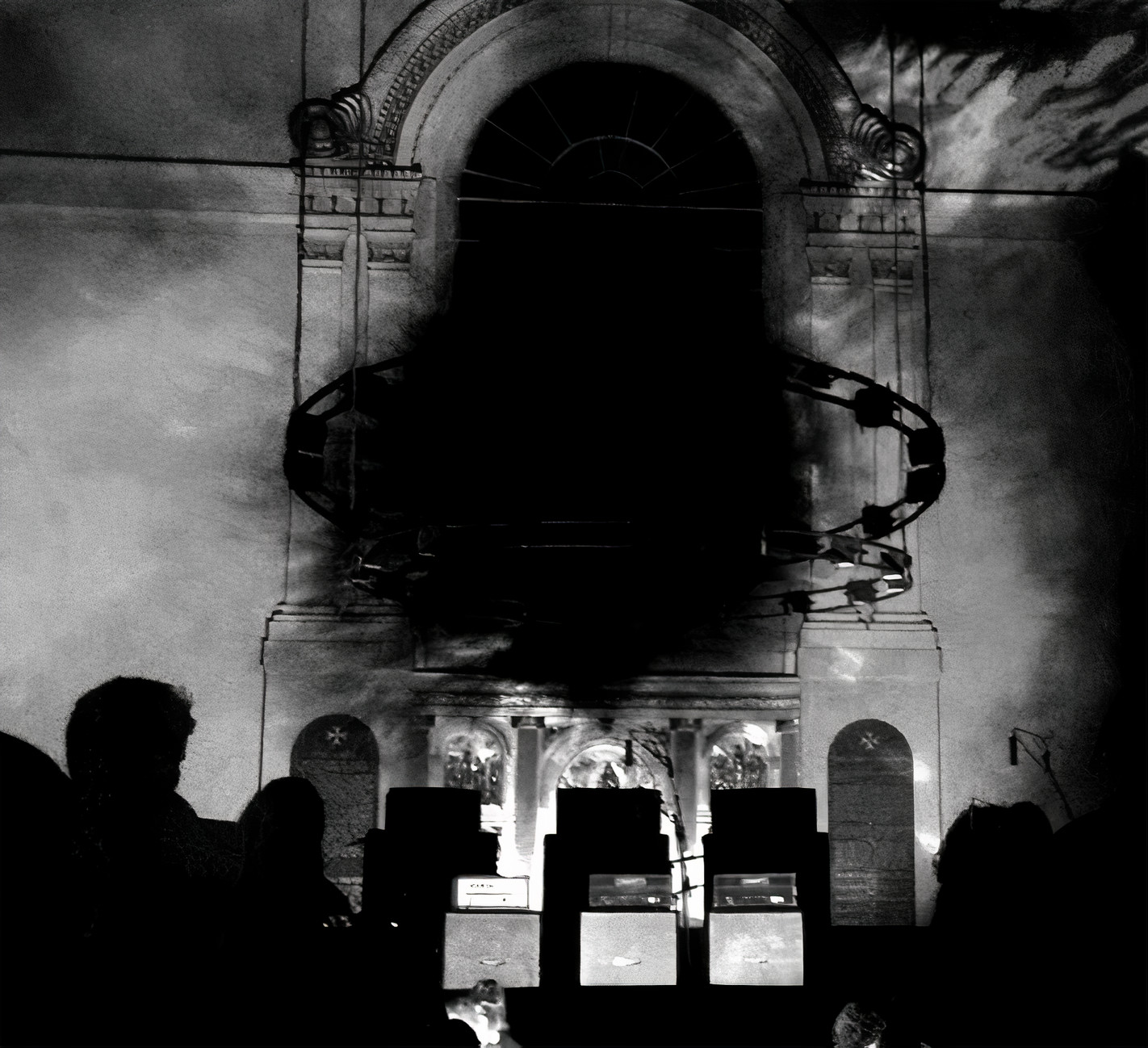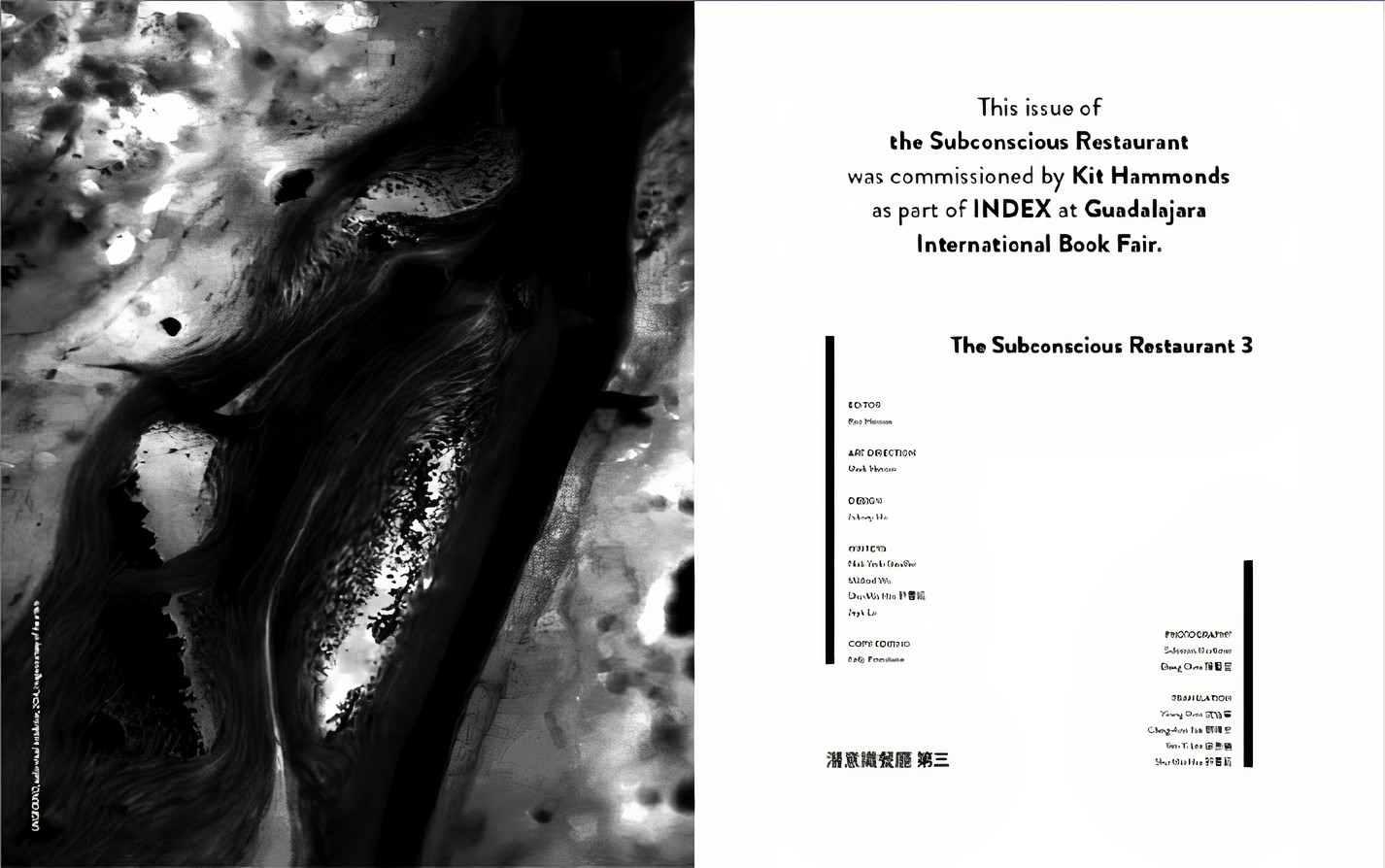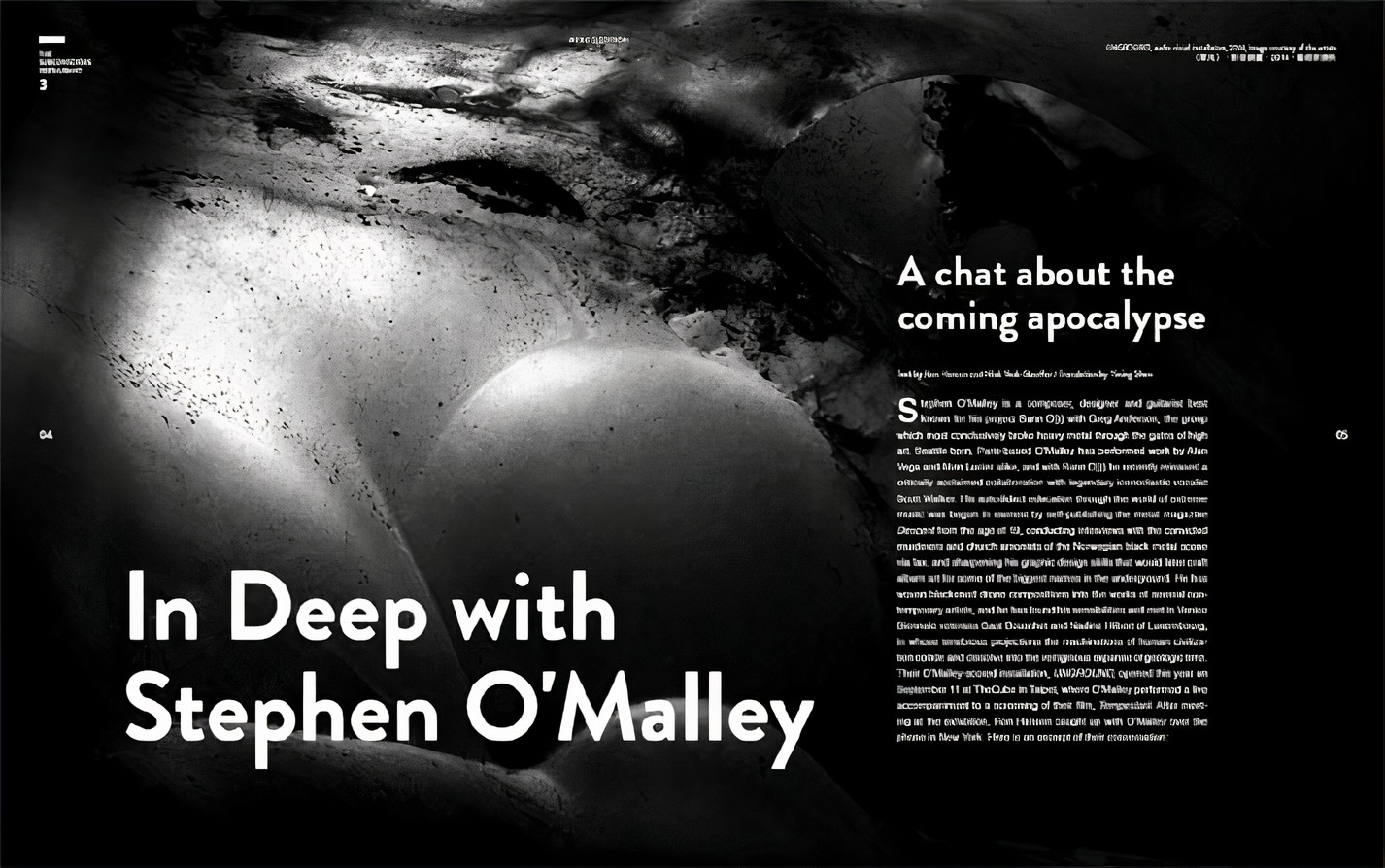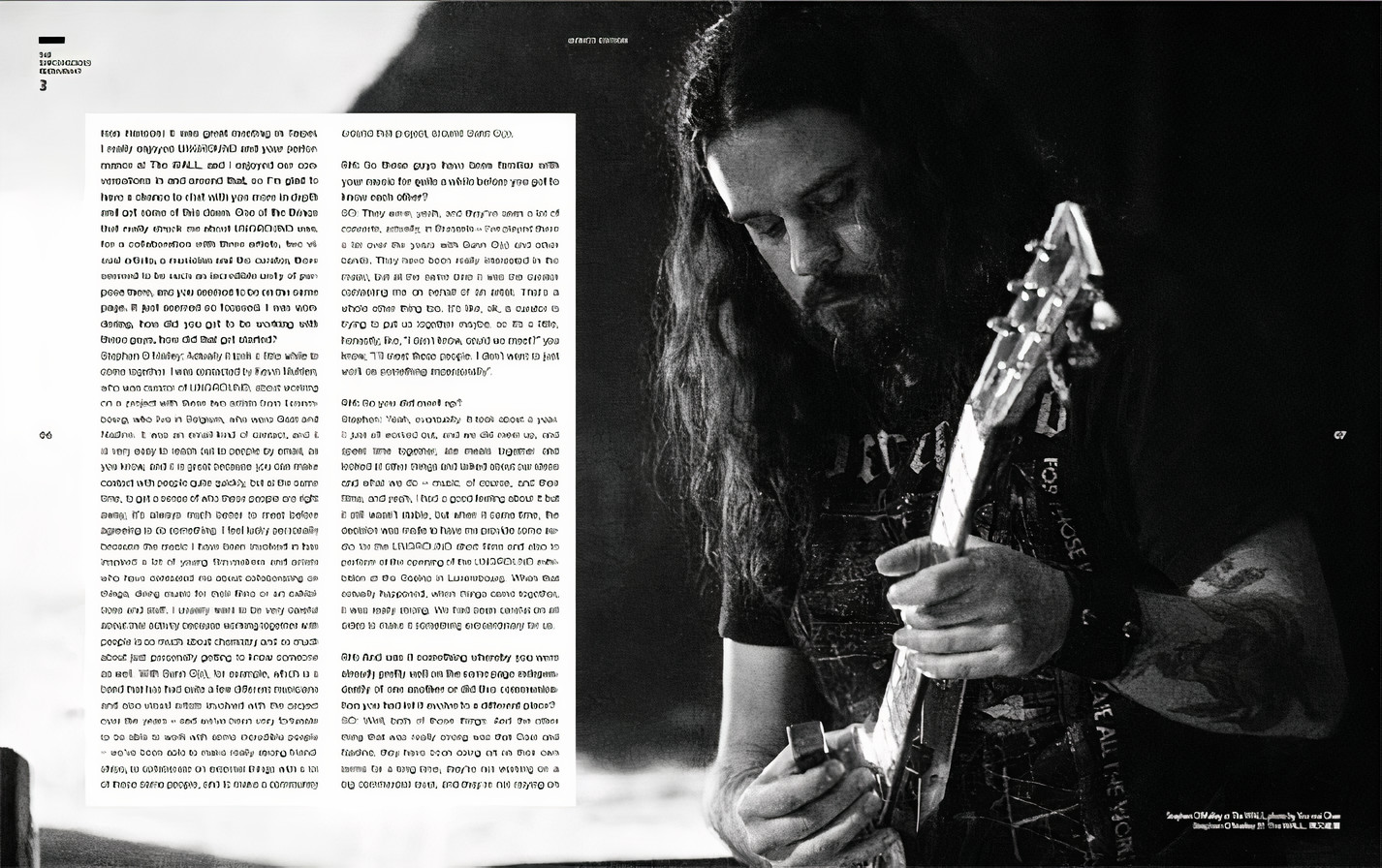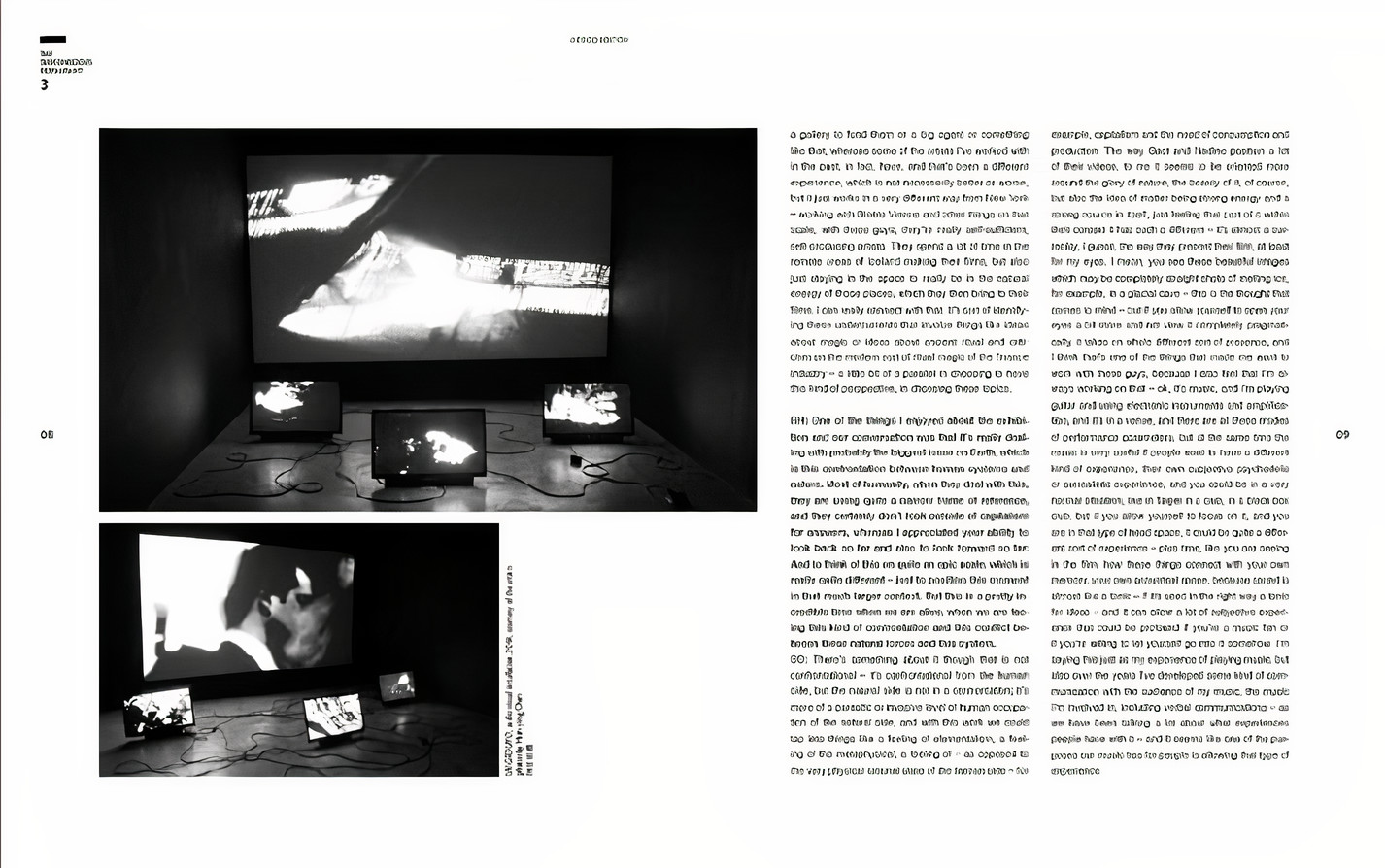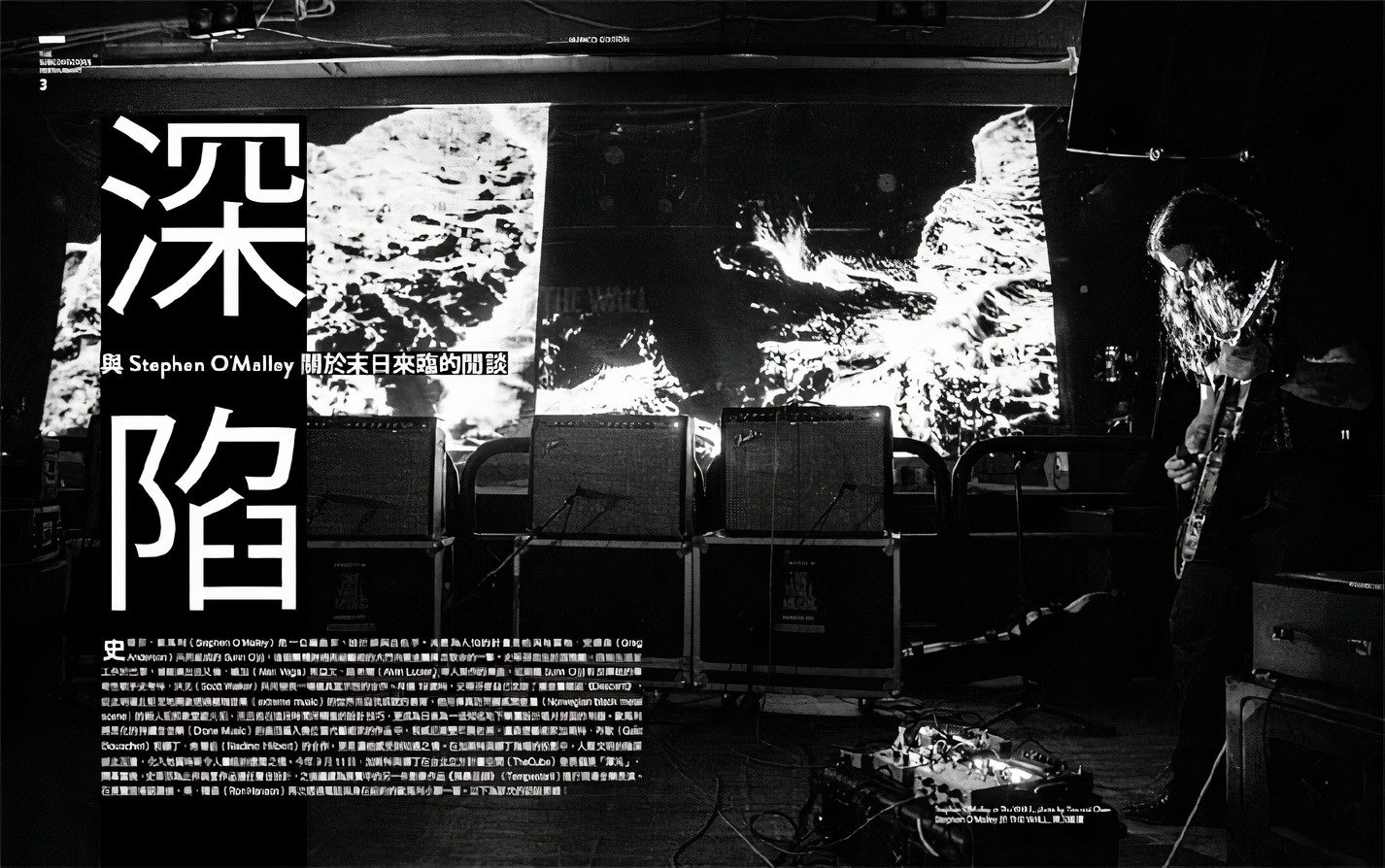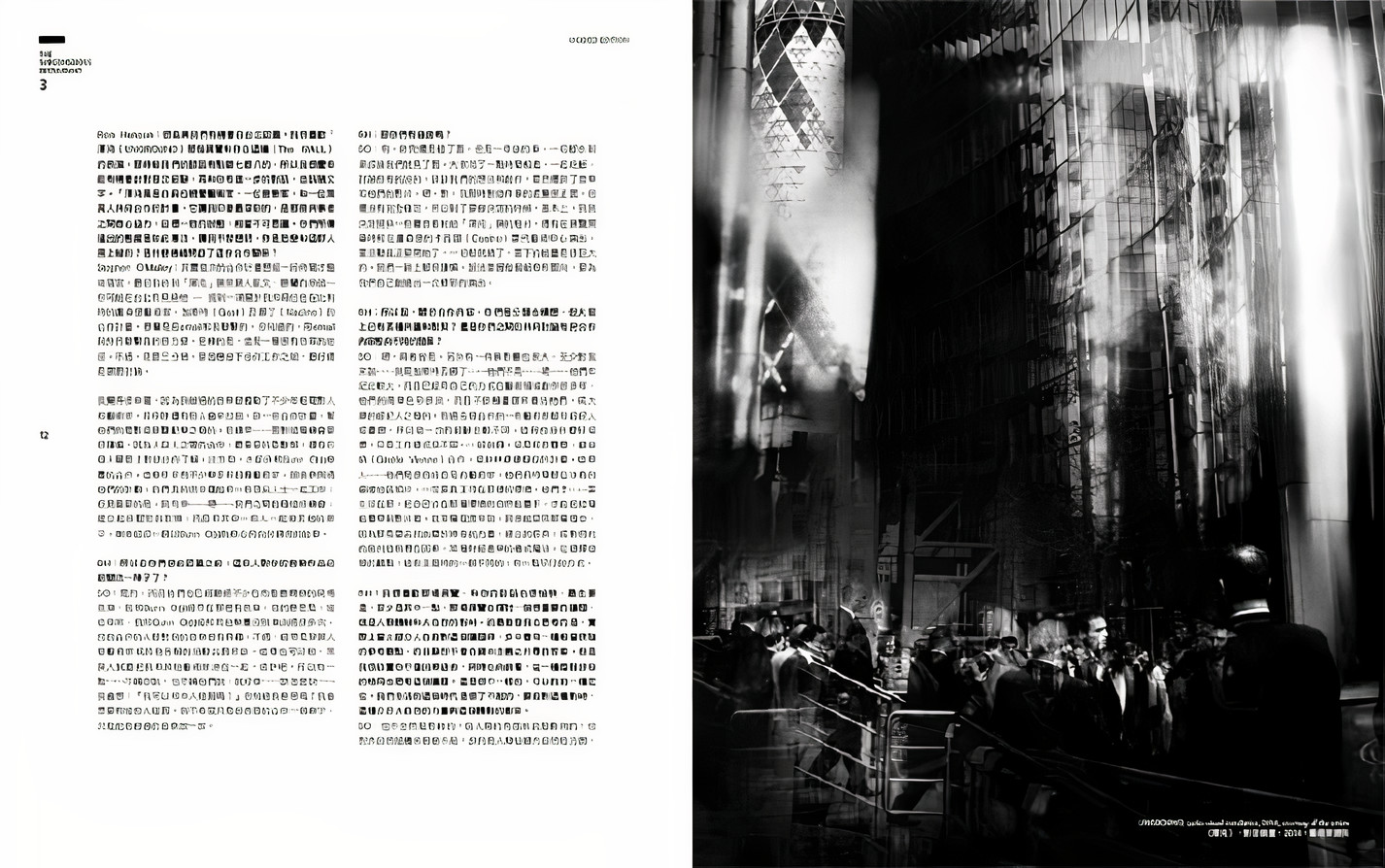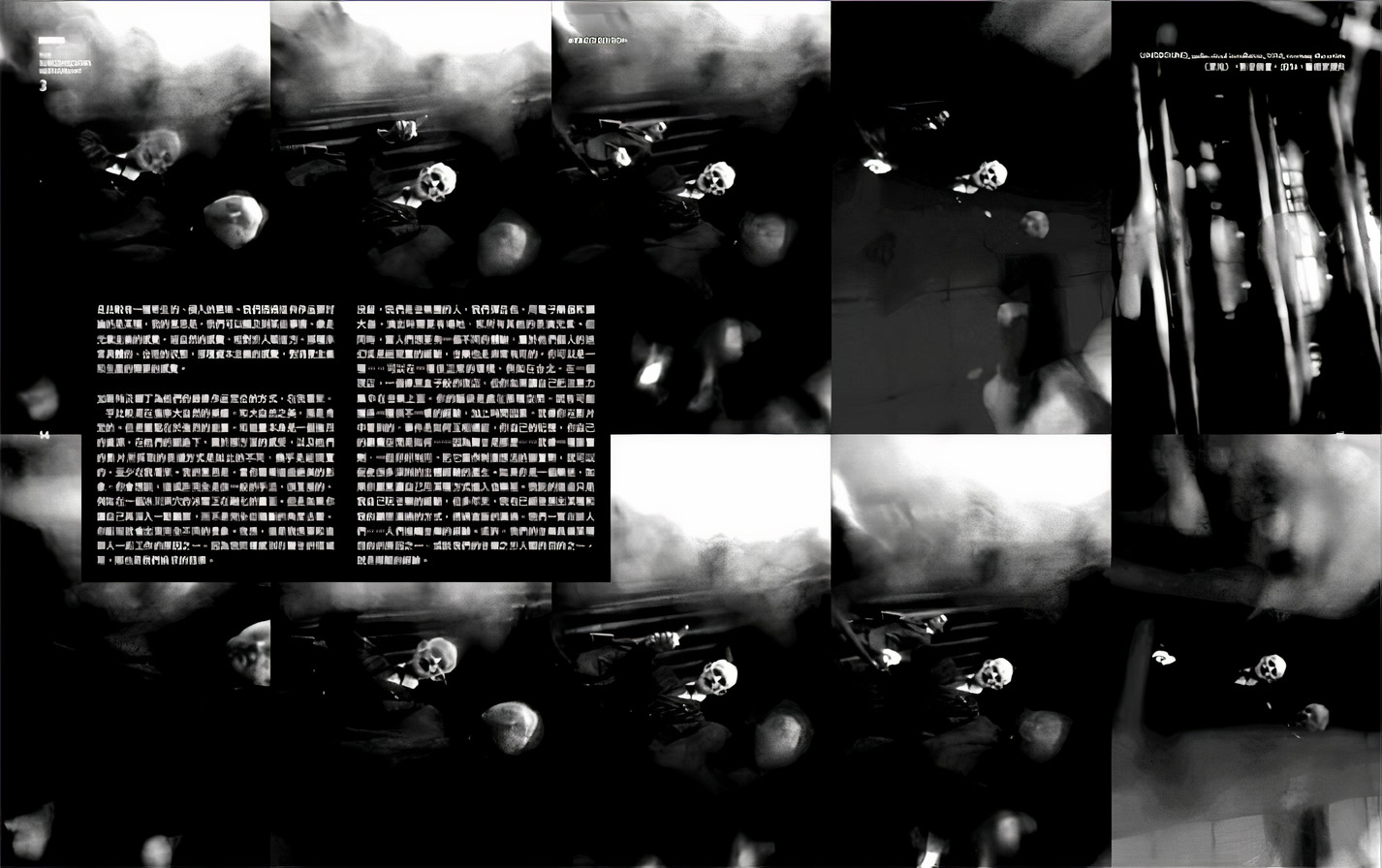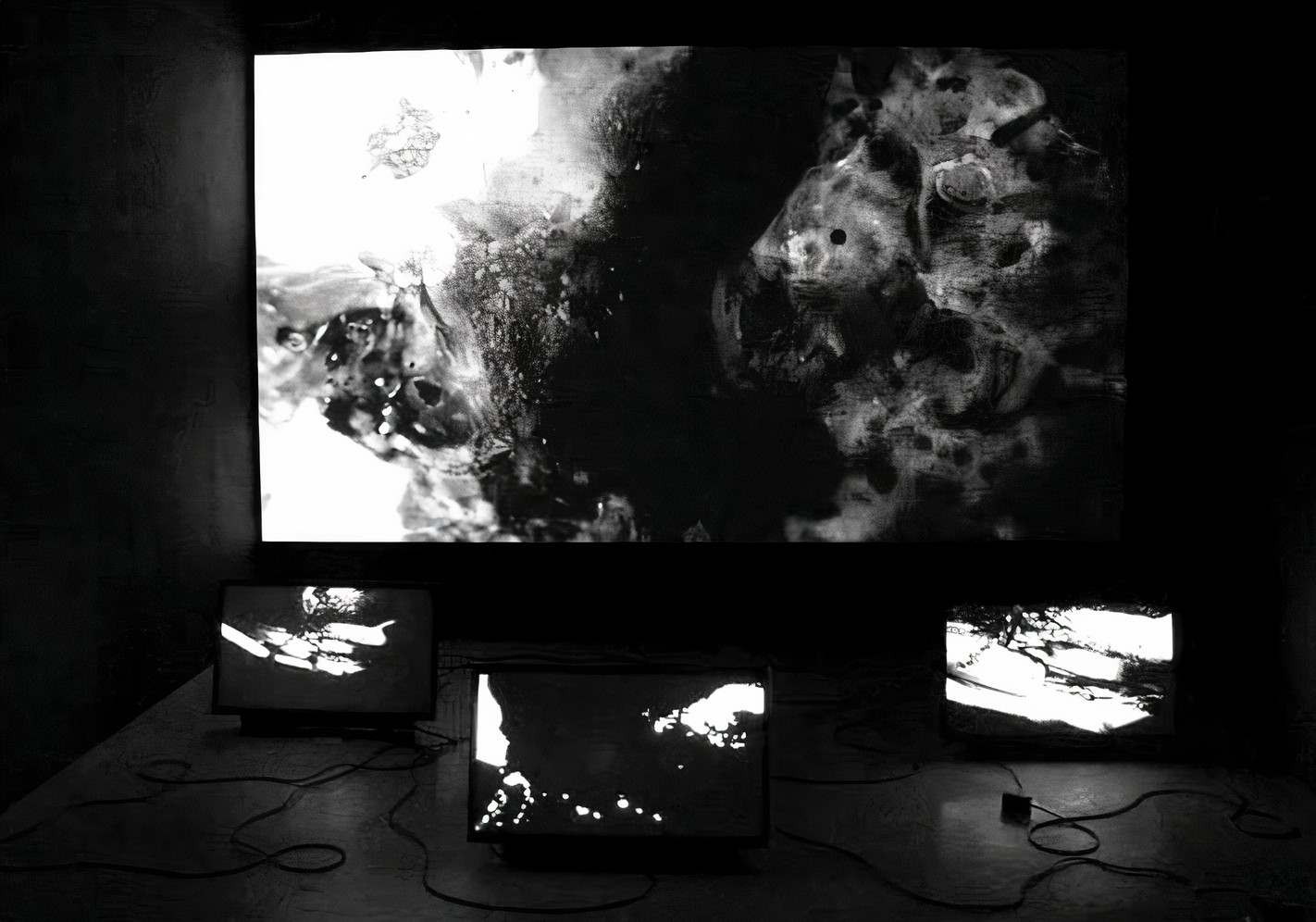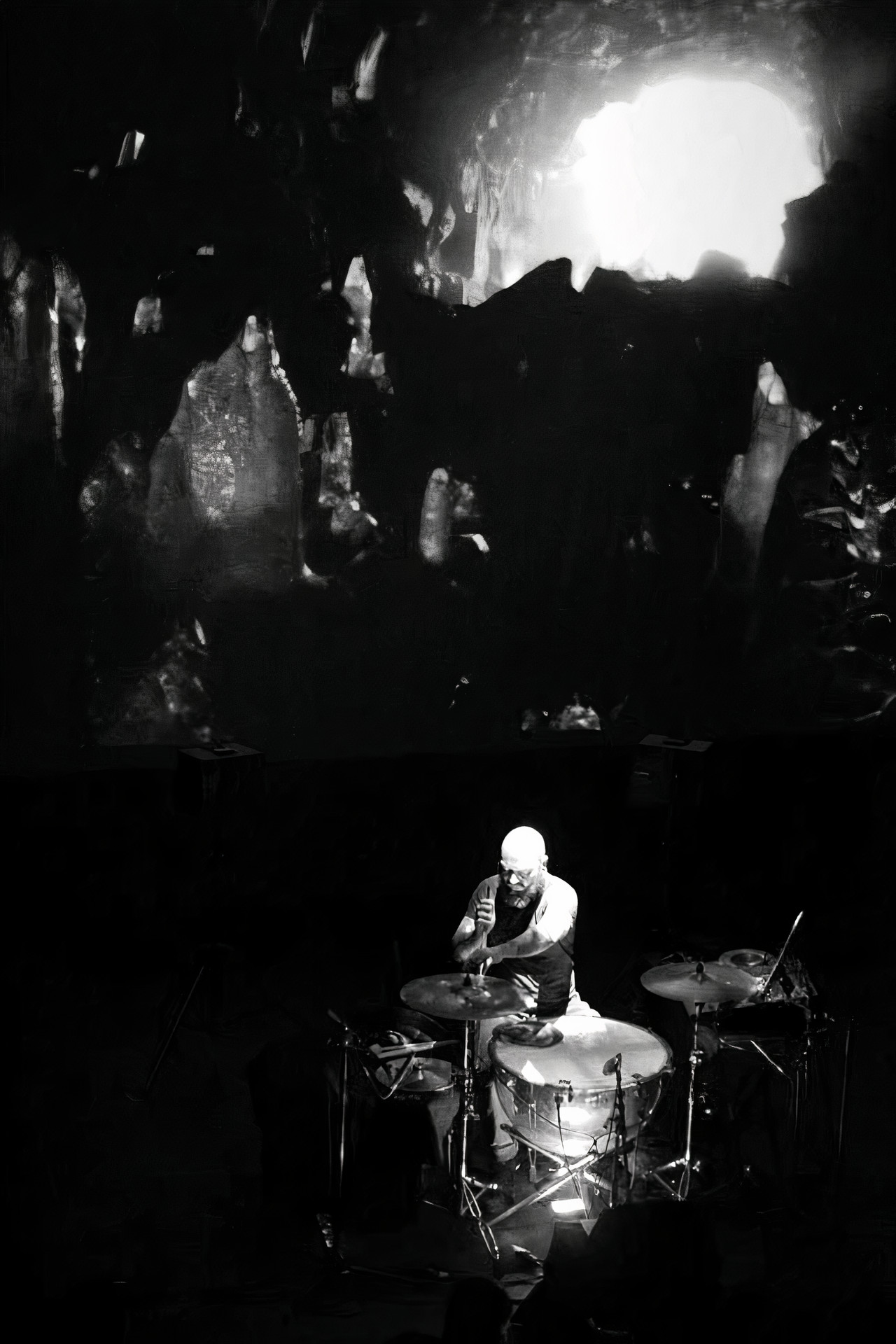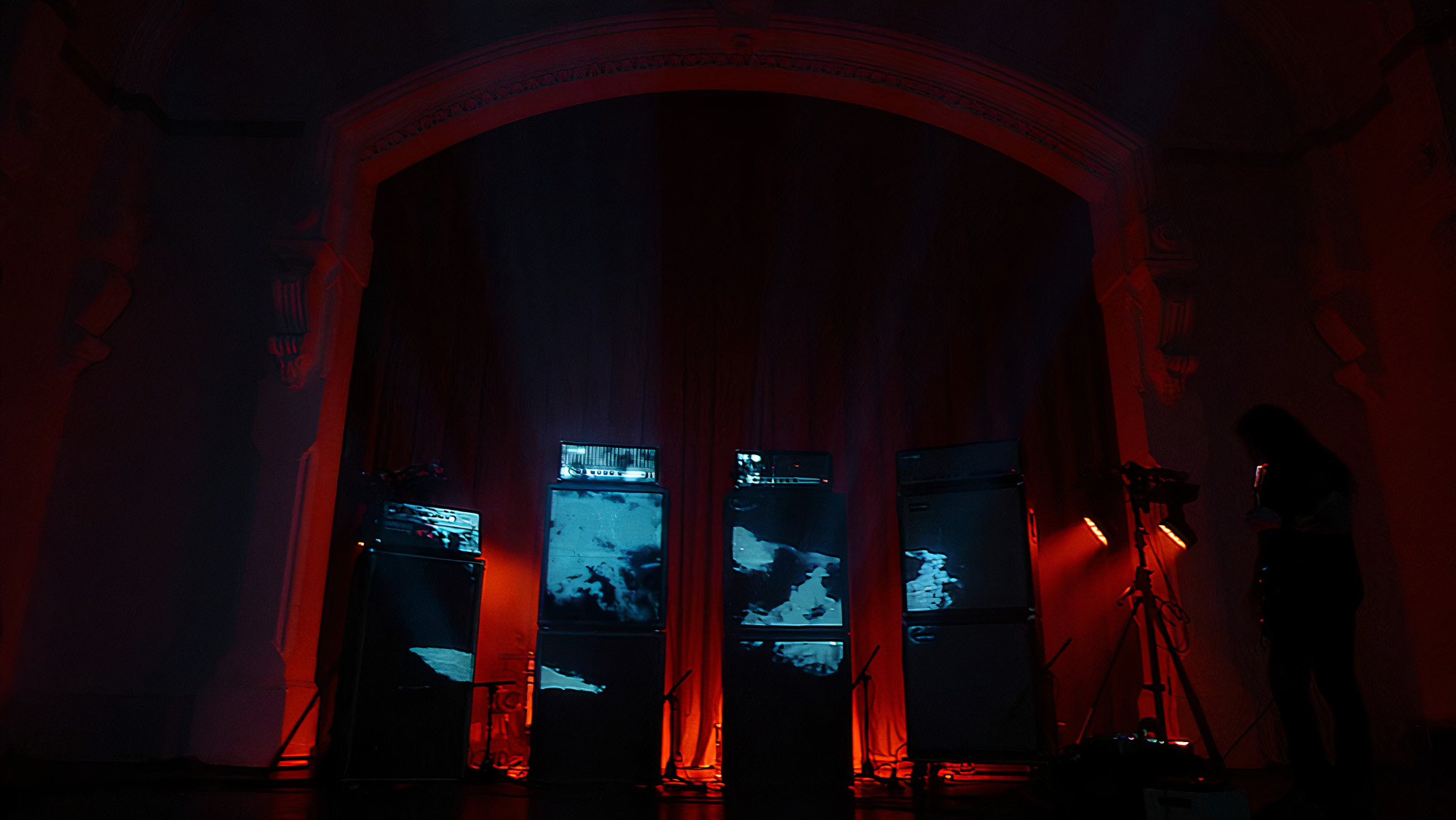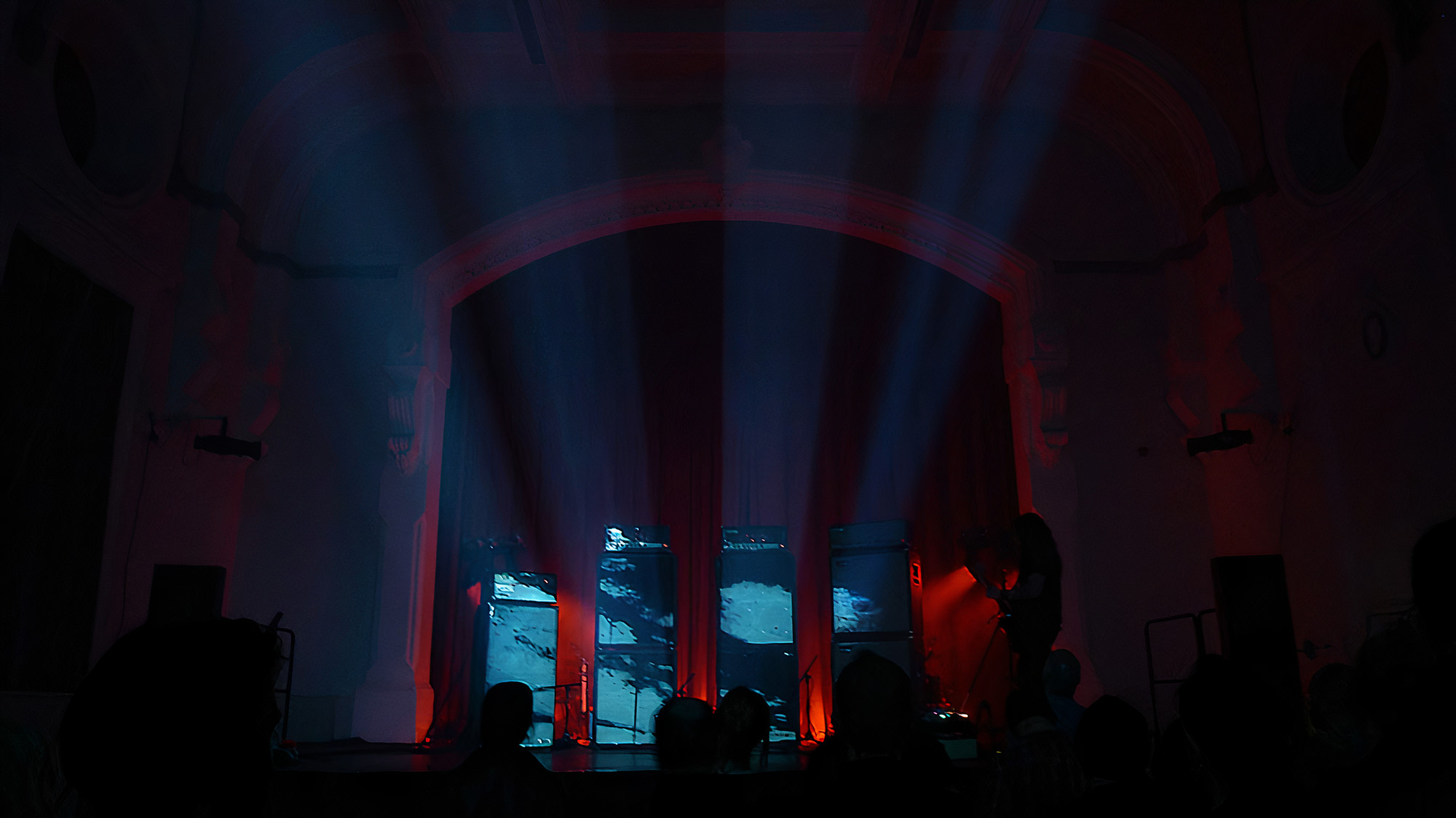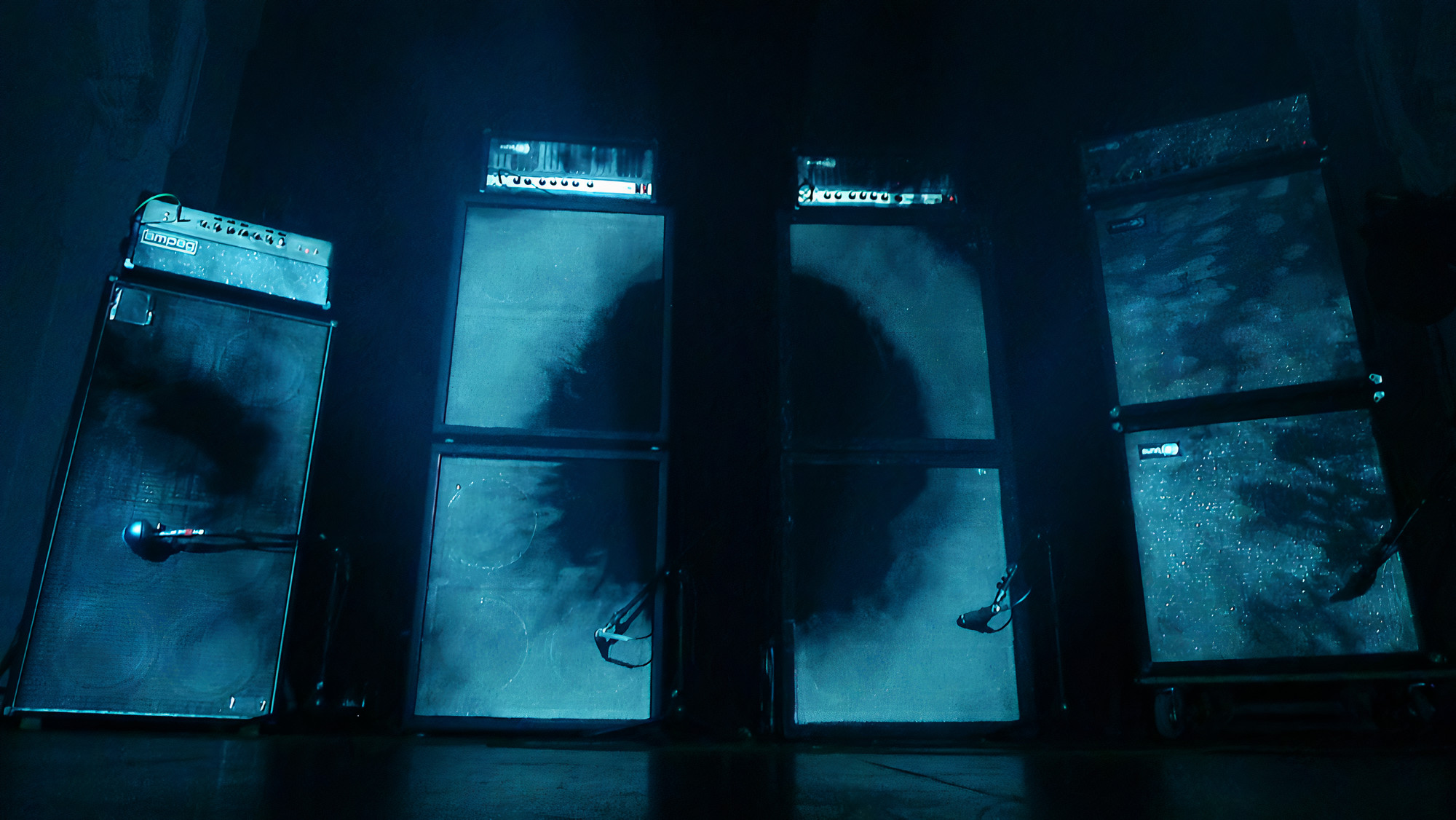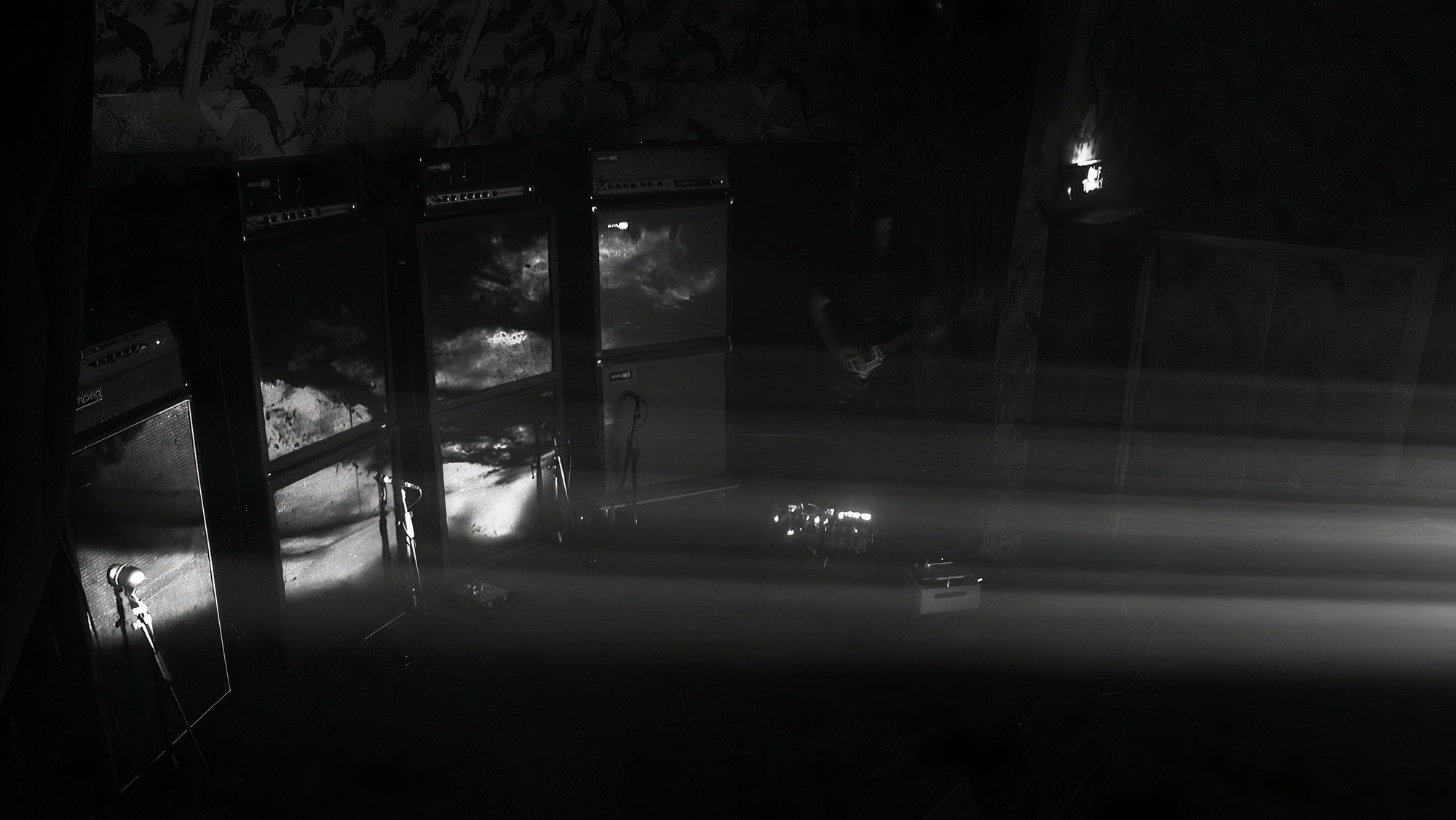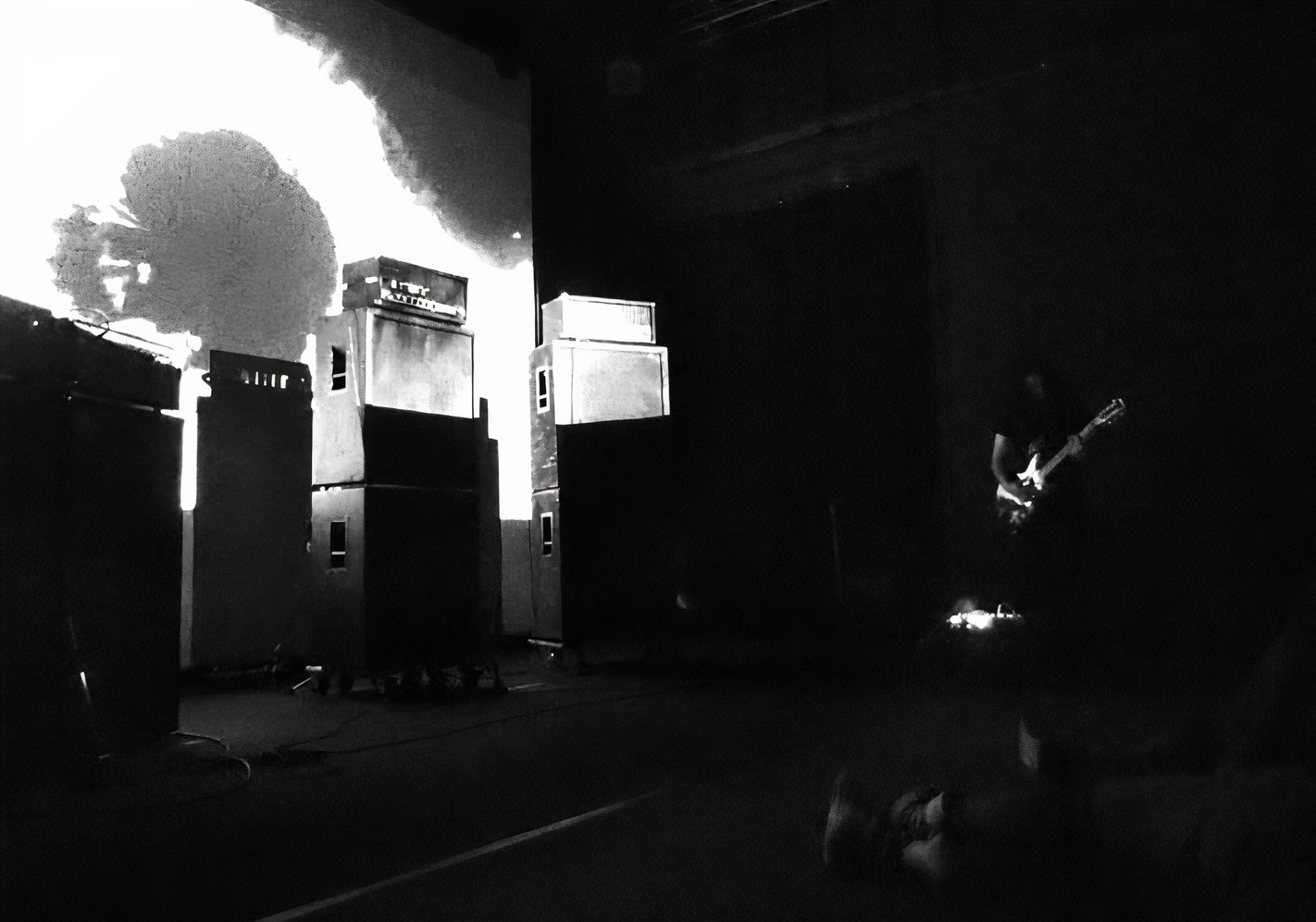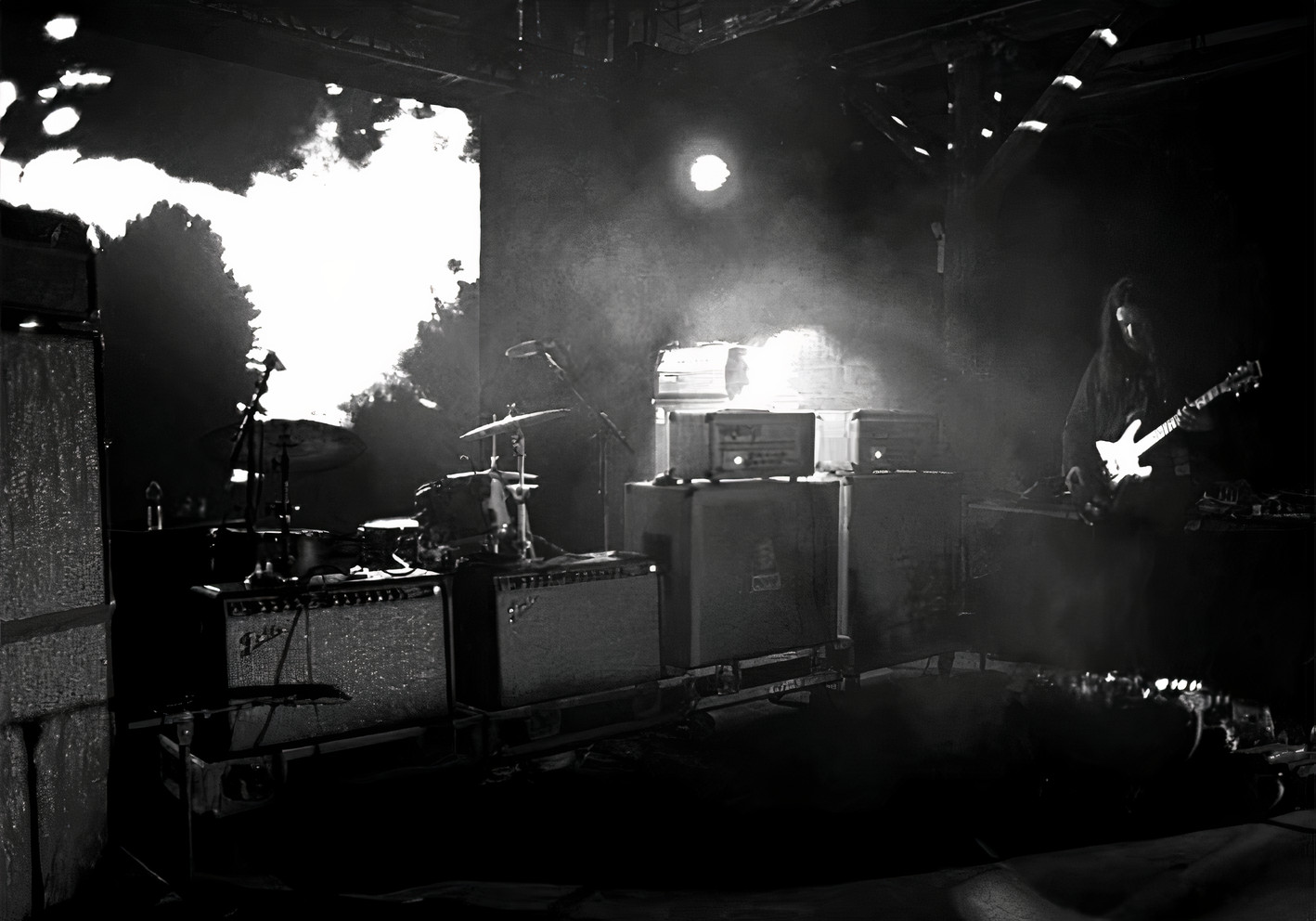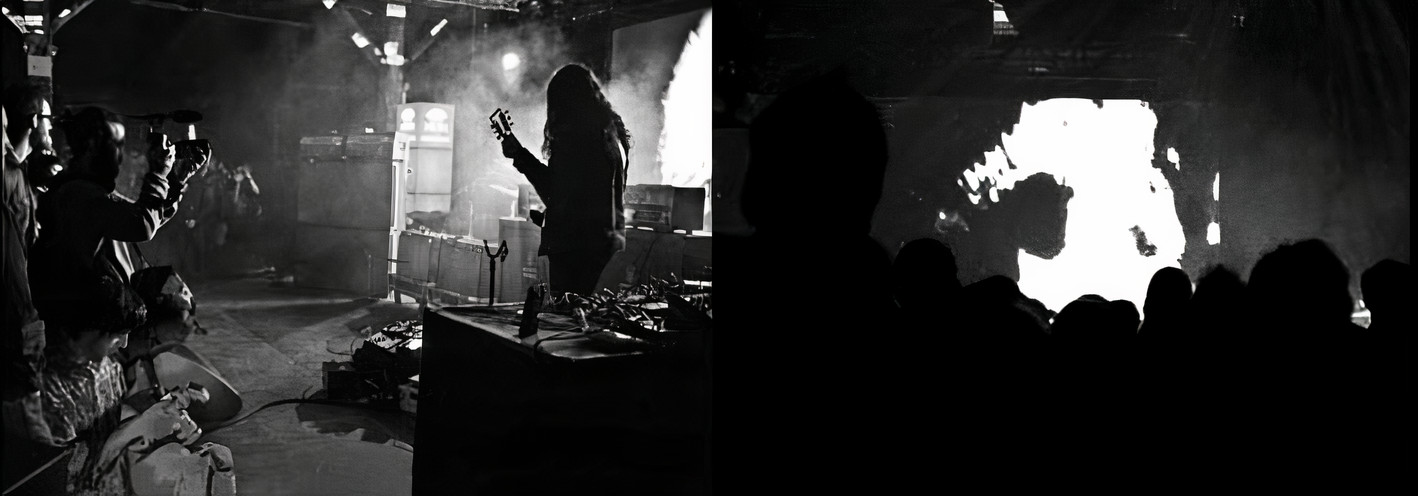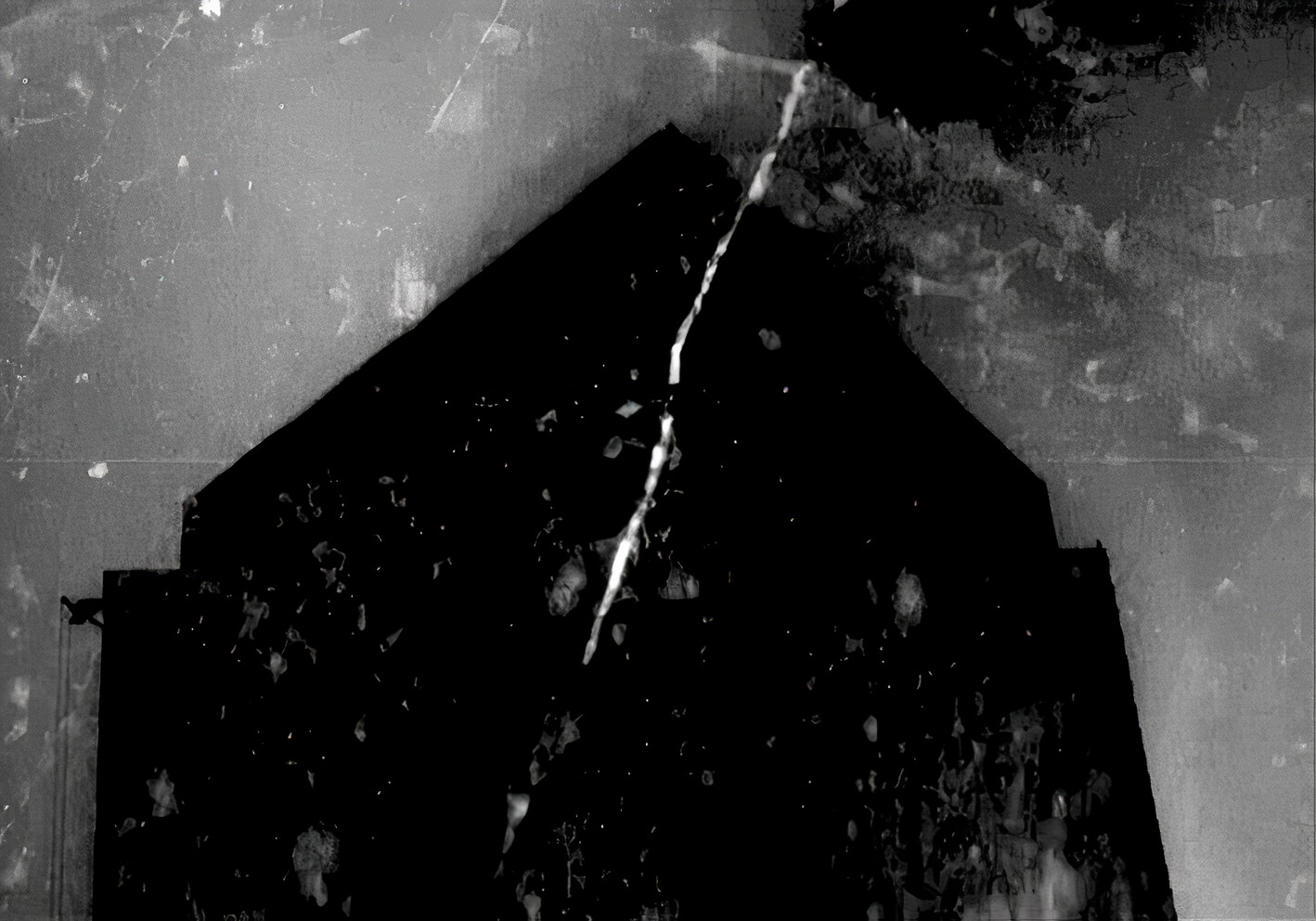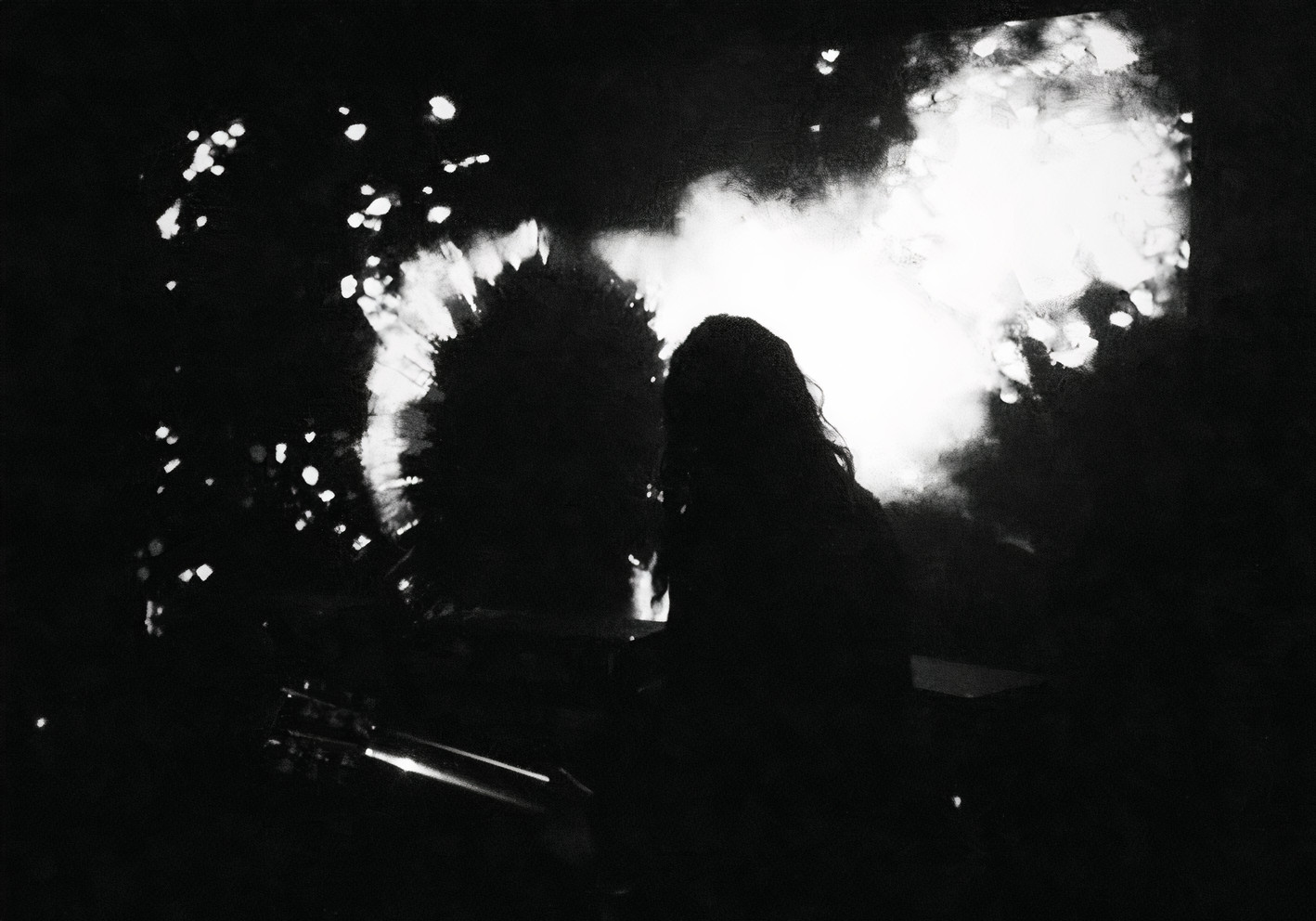UNGROUND EXTENDED
Kunstenfestivaldesarts, May 28, 2016
The video was projected on water vapour.
Stephen describes it as “a testimony to the choreographic beauty of the movement of a swirling dust stream”, in his introductory text to my book Anarch.
SOMA + Unground, Musicbox, Lisboa
February 27, 2016
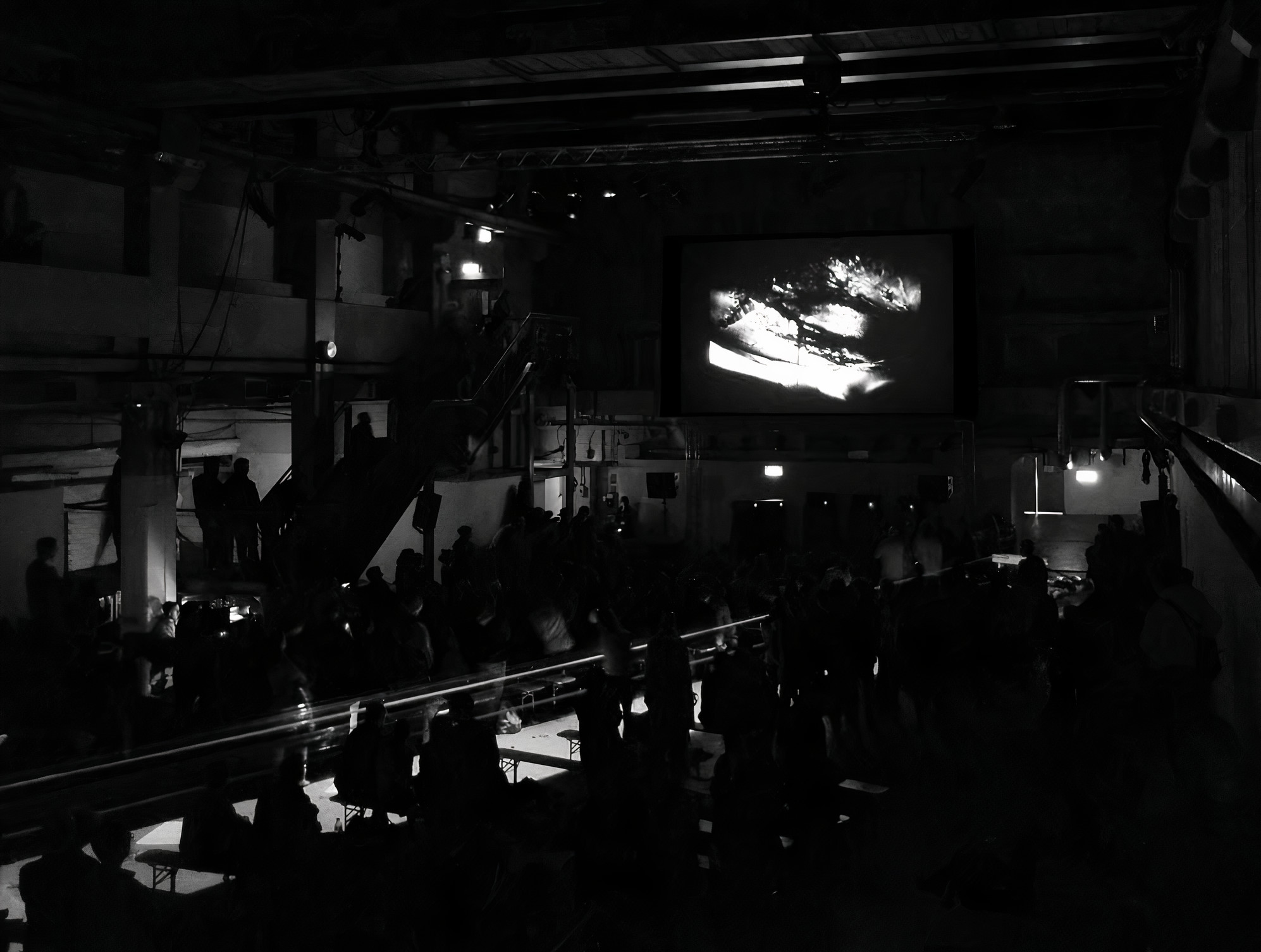
London Contemporary Music Festival 2015
Ambika-3, 13th December 2015
Stephen O’Malley’s thunderous, crashing guitar barrage, a continual exploration and reprocessing of chords that could have been extracted from Pete Townsend’s repertoire with The Who, created a monumental endnote, in intentionally curated contrast to Fullman’s brightly subdued butterfly net of wire sounds. A monochrome film which metamorphosed from the viscerally dripping bowels of the earth to fizzling catherine wheel firework revolutions served as a visual point of reference above O’Malley playing in near-darkness by his bank of speakers, as thrumming whirlpools of raw rhythm bled in to the space.
http://www.londonjazznews.com/2015/12/review-five-ways-to-kill-time-at-ambika.html
SOMA + Unground, The Tinnitus Music Series, National Sawdust, Brooklyn
OCT. 26, 2015
Unground, Darling Foundry, Montreal, Canada
Music: Stephen O’Malley
Curator: Kevin Muhlen
Modernist architecture immersed in a murky haze, threatening abyssal chasms, video images in black and white crossed by perpetual motion flow, and streaming end of the world experimental tones by Stephen O’Malley, UNGROUND, the multi-layered installation curated by Kevin Muhlen, artistic director at Casino Luxembourg, opens our 2015 season, offering visitors an immersive, sensitive and thought-provoking experience.
Unground is an immersive multi-channel video installation bursting with references to the mineral understructures of the modern metropolis, financial meltdowns, thawing glaciers, archaic caves and volcanic, arctic wastelands at the border of the inhabitable world. It is an invitation to feel, think and meditate the forces which have cut off human beings from the rest of nature. Our civilization has reached a crisis point – the surface of our planet has been profoundly transformed by economies of excess and capitalist consumerism. As a result, Unground has transformed these feelings of alienation and cultural estrangement into sorcerous gestures of insurrection. It reevaluates experiences of anger and discontent in order to face the threats of a civilization that is heading towards the abyss. The video installations, representing both modern city infrastructures and inhabitable Arctic wildernesses, offer an alternative understanding of our world beyond the limits of capitalist realism. They suggest a manner of resistance and dissent, opening a gateway to a dark and secret realm charged with new freedoms and possibilities.
– Caroline Andrieux
THE LINK, Fringe Arts, February 17, 2015
A roar to shake the world’s foundations
Art Exhibition Unground Explores the Excesses of Capitalist Consumerism
by Mattha Busby @itsmattha
Prepare to be immersed in a land which you had thought to be inconceivable: a world without capitalism. This exhibition will whisk you away from the conservative grounding most of us are long-familiar with.
From Feb. 27 to March 15, Montrealers can take in Unground, a multi-dimensional, multichannel video installation containing references to what the press release describes as “mineral understructures of the modern metropolis, financial meltdowns, thawing glaciers, archaic caves and volcanic, arctic wastelands at the border of the inhabitable world.” The exhibition presented at Darling Foundry, a contemporary visual arts centre in the Old Port, will display the work of Gast Bouschet and Nadine Hilbert, Luxembourg artists who have collaborated for more than 30 years. By juxtaposing images of modern cities and the Arctic tundra, the show suggests an alternative to capitalist realism—a term describing the ubiquitous influence of capitalism on virtually all aspects of life.
“Offering an alternative to capitalist realism is certainly a challenge isn’t it?” mused Bouschet.
“Despite all rational and pragmatic arguments in favour of capitalism as the lesser evil,” he continued, “The fact that it is easier for us nowadays to imagine the end of the world than the end of capitalism shows how effective its spell is.” The content featured in the latter stages of the video installation, when the exhibition showed in Luxembourg in 2012, includes volcanic ash smeared over images of the backdrop of the modern landmarks in London’s financial centre, such as The Gherkin. These shots are juxtaposed with footage shot in Iceland, slowed down so as to give the audience a glimpse of eternity. Expect something similar in Montreal this year to what was on display in Luxembourg.
The Darling Foundry is a former metal works factory that is now a post-industrial reappropriated space. The parallels between the exhibition space and the exhibition’s content itself are inescapable. “We didn’t add anything; we just tried to take out all the things that were not usable anymore, like the heating system and poles all over the space,” said Caroline Andrieux, founder and artistic director at the Darling Foundry, in a 2013 interview with The Link.
“It was more a work of purification. We’re happy because we saved the building as it was.” Capitalism is a ruthless economic system; it forgets and it never forgives. It sheds the disposable and retains only what it considers invaluable.
This exhibition challenges its audience to consider alternatives to the economic system political scientist Francis Fukuyama famously argued would mark “the end of history”—the neoliberal structure we live in today. The artists invite their audience to “feel, think and meditate the forces which have cut off human beings from the rest of nature,” as explained on the Darling Foundry’s website. Seeking to empower themselves and the audience by opening up the world to underground currents through the installation, the artists seek to create a zone where physical and mental experiences become accessible to the public. As the ozone layer exposes further holes, like when you wear one of your grandmother’s sweatshirts for too long, our globe becomes further enveloped by the worldwide division of labour which the invisible hand of capitalism tends to demand.
The exhibition’s intention is to transform “these feelings of alienation and cultural estrangement into sorcerous gestures of insurrection.” Bouschet explained that he and Hilbert aim to promote the “liberation and redistribution of power” in creating a space where one ponders “the right to develop one’s own world view and create one’s own values.” The exhibition features multiple installations on different platforms, which are as important as the tangible matter in the space. There’s an ironic parallel between the comprehensive submergence of the installation and the comprehensive experience of capitalism.
“The sound of the installation, developed by Stephen O’Malley, is as important as the visual noise that we are feeding into it,” Bouschet said. Stephen O’Malley is one of two founding members of drone metal pioneers Sunn O))). The long-duration tones of drone and doom metal facilitate a meditative experience where one can become enveloped in sound in mere seconds.
Along with writers Bataille, Nietzsche and Artaud, the artists are profoundly influenced by black metal theory and have previously collaborated with Amelia Ishmael, editor of black metal theory journal Helvete.
The artists are “excited to see what our work can do inside that huge industrial building,” according to Bouschet. “We have only seen images, and we can’t wait to experience the physicality of the space.” Bouschet describes the exhibition, which opens next week, as where “today’s incredibly hectic world gets to meet something where time is stretched out and where various time zones [deep or geological time] run in parallel to each other.”
http://thelinknewspaper.ca/article/6725
http://thelinknewspaper.ca/pdf/v35i21w.pdf
See more at http://fonderiedarling.org/en/Unground.html
Stephen O’Malley live at St John at Hackney
London, 8 November 2014
And here comes the noise, a deep, bassy rumble that, even several rows back, is actually physical in its intensity. Above his head are projections of melting glaciers, water seeming to run down the back wall of the church, and it’s almost as if the roof has gone and the terribly portentous London weather has made its way inside. […]
http://freq.org.uk/reviews/bohren-omalley-live-st-john-hackney/
In Deep with Stephen O’Malley
Text by Ron Hanson and Nick Yeck-Stauffer / Translation by Yining Shen
The Subconscious Restaurant is a publication by White Fungus Magazine
See more at:http://whitefungus.com/
Stephen O’Malley is a composer, designer and guitarist best known for his project Sunn O))) with Greg Anderson, the group which most conclusively broke heavy metal through the gates of high art. Seattle-born, Paris-based O’Malley has performed work by Alan Vega and Alvin Lucier alike, and with Sunn O))) he recently released a critically acclaimed collaboration with legendary iconoclastic vocalist Scott Walker. His autodidact education through the world of extreme music was begun in earnest by self-publishing the metal magazine Descent from the age of 19, conducting interviews with the convicted murderers and church arsonists of the Norwegian black metal scene via fax, and sharpening his graphic design skills that would later craft album art for some of the biggest names in the underground. He has woven blackened drone compositions into the works of several contemporary artists, and he has found his sensibilities well met in Venice Biennale veterans Gast Bouschet and Nadine Hilbert of Luxembourg, in whose tenebrous projections the machinations of human civilization collide and dissolve into the vertiginous expanse of geologic time. Their O’Malley-scored installation, UNGROUND, opened this year on September 11 at TheCube in Taipei, where O’Malley performed a live accompaniment to a screening of their film, Tempestarii. After meeting at the exhibition, Ron Hanson caught up with O’Malley over the phone in New York. Here is an excerpt of their conversation:
Ron Hanson: It was great meeting in Taipei. I really enjoyed UNGROUND and your performance at The WALL, and I enjoyed our conversations in and around that, so I’m glad to have a chance to chat with you more in-depth and get some of this down. One of the things that really struck me about UNGROUND was, for a collaboration with three artists, two visual artists, a musician and the curator, there seemed to be such an incredible unity of purpose there, and you seemed to be on the same page. It just seemed so focused. I was wondering, how did you get to be working with these guys, how did that get started?
Stephen O’Malley: Actually it took a little while to come together. I was contacted by Kevin Muhlen, who was curator of UNGROUND, about working on a project with these two artists from Luxembourg, who live in Belgium, who were Gast and Nadine. It was an email kind of contact, and it is very easy to reach out to people by email, as you know, and it is great because you can make contact with people quite quickly, but at the same time, to get a sense of who these people are right away, it’s always much better to meet before agreeing to do something. I feel lucky personally because the music I have been involved in has inspired a lot of young film-makers and artists who have contacted me about collaborating on things, doing music for their films or art exhibitions and stuff. I usually want to be very careful about that activity because working together with people is so much about chemistry and so much about just personally getting to know someone as well. With Sunn O))), for example, which is a band that has had quite a few different musicians and also visual artists involved with the project over the years – and we’ve been very fortunate to be able to work with some incredible people – we’ve been able to make really strong friendships, to collaborate on external things with a lot of these same people, and to make a community around that project, around Sunn O))).
RH: So these guys have been familiar with your music for quite a while before you got to know each other?
SO: They were, yeah, and they’ve seen a lot of concerts, actually, in Brussels – I’ve played there a lot over the years with Sunn O))) and other bands. They have been really interested in the music, but at the same time it was the curator contacting me on behalf of an artist. That’s a whole other thing too. It’s like, ok, a curator is trying to put us together maybe, so it’s a little, honestly, like, “I don’t know, could we meet?” you know, “I’ll meet these people. I don’t want to just work on something impersonally”.
RH: So you did meet up?
SO: Yeah, eventually. It took about a year. It just all worked out, and we did meet up, and spent time together, ate meals together and looked at other things and talked about our ideas and what we do – music, of course, and their films, and yeah, I had a good feeling about it but it still wasn’t stable, but when it came time, the decision was made to have me provide some audio for the UNGROUND short films and also to perform at the opening of the UNGROUND exhibition at Casino in Luxembourg. When that actually happened, when things came together, it was really strong. We had been careful on all sides to make it something extraordinary for us.
RH: And was it something whereby you were already pretty well on the same page independently of one another or did this communication you had let it evolve to a different place?
SO: Well, both of those things. And the other thing that was really strong was that Gast and Nadine, they have been doing art on their own terms for a long time, they’re not working on a big commercial level, and they’re not relying on a gallery to fund them or a big agent or something like that, whereas some of the artists I’ve worked with in the past, in fact, have, and that’s been a different experience, which is not necessarily better or worse, but it just works in a very different way from New York – working with Gisèle Vienne and other things on that scale, with these guys, they’re really self-sufficient, self-producing artists. They spend a lot of time in the remote areas of Iceland making their films, but also just staying in the space to really be in the natural energy of those places, which they then bring to their films, I can really connect with that. It’s sort of identifying these undercurrents that involve things like ideas about magic or ideas about ancient ritual and criticism on the modern sort of ritual magic of the finance industry – a little bit of a parallel in choosing to have this kind of perspective, in choosing these topics.
RH: One of the things I enjoyed about the exhibition and our conversation was that it’s really dealing with probably the biggest issue on Earth, which is this confrontation between human systems and nature. Most of humanity, when they deal with this, they are using quite a narrow frame of reference, and they certainly don’t look outside of capitalism for answers, whereas I appreciated your ability to look back so far and also to look forward so far. And to think of this on quite an epic scale, which is really quite different – just to position this moment in that much larger context. But this is a pretty incredible time when we are alive, when we are facing this kind of confrontation and this conflict between these natural forces and this system.
SO: There’s something about it though that is not confrontational – it’s confrontational from the human side, but the natural side is not in a confrontation; it’s more of a parasitic or invasive level of human occupation of the natural side, and with this work we could tap into things like a feeling of elementalism, a feeling of the metaphysical, a feeling of – as opposed to the very physical rational state of the human side – for example, capitalism and the need of consumption and production. The way Gast and Nadine position a lot of their videos, to me it seems to be oriented more around the glory of nature, the beauty of it, of course, but also the idea of matter being strong energy and a strong source in itself; just feeling that part of it within their context it has such a different – it’s almost a surreality, I guess, the way they present their film, at least for my eyes. I mean, you see these beautiful images which may be completely straight shots of melting ice, for example, in a glacial cave – this is the thought that comes to mind – but if you allow yourself to open your eyes a bit more and not view it completely pragmatically, it takes on whole different sort of presence, and I think that’s one of the things that made me want to work with these guys, because I also feel that I’m always working on that – ok, it’s music, and I’m playing guitar and using electronic instruments and amplification, and it’s in a venue, and there are all these modes of performance parameters, but at the same time the music is very useful if people want to have a different kind of experience, their own subjective psychedelic or surrealistic experience, and you could be in a very normal situation, like in Taipei in a club, in a black box club, but if you allow yourself to focus on it, and you are in that type of head space, it could be quite a different sort of experience – plus time, like you are seeing in the film, how these things connect with your own memory, your own acoustical space, because sound is almost like a tonic – if it’s used in the right way a tonic for ideas – and it can allow a lot of subjective experience that could be profound if you’re a music fan or if you’re willing to let yourself go into it somehow. I’m saying this just as my experience of playing music, but also over the years I’ve developed some kind of communication with the audience of my music, the music I’m involved in, including verbal communications – as we have been talking a lot about what experiences people have with it – and It seems like one of the purposes our music has for people is allowing that type of experience.
Unground @ CubeSpace Taipei
Eight channel video installation
Music by Stephen O’Malley
Curator: Amy Cheng, Kevin Muhlen
CubeSpace, Taipei, Taiwan
Sept.11 – Nov 23, 014
Date | September 11th – November 23rd, 2014
Opening Reception | 16:00 / September 11th, 2014 @ The Cube
Live Performance of Tempestarii | 20:00 / September 11th @ The Wall Live House
(More information http://thewall.tw/shows/927 )
TheCube Project Space of Taipei, in collaboration with Casino Luxembourg – Forum d’art contemporain, is pleased to present on September 11th UNGROUND, an 8-channel audio-visual installation by Luxembourgish artist-duo Gast Bouschet and Nadine Hilbert. Kevin Muhlen, artistic director of Casino Luxembourg, where the exhibition had its first reveal in 2012, is curating the Taipei exhibition.
UNGROUND’s visit to Taipei is part of a cultural exchange program between Taiwan and Luxembourg. Shared interests and enthusiasm for contemporary art brought Casino Luxembourg and TheCube into discussions on ways to extend and deepen mutual exchange opportunities. Casino Luxembourg Director and Curator Kevin Muhlen is spearheading the program to invite Luxembourgish artists to Taiwan. For its part, TheCube is currently developing a program with Casino to bring an exhibition by three Taiwanese artists to Luxembourg in the spring of 2015.
Gast Bouschet and Nadine Hilbert have recreated UNGROUND for its premier in Taipei. A more highly integrated, 8-channel video installation narrates the liquefaction of solid matter into a complexity of flows. Images symbolically interweave references to the alchemical process of dissolution, immersing viewers in a pronounced feeling that the entire global civilization is melting away.
Tempestarii is a live performance that will take place on the exhibition’s opening evening at The Wall live house. This is a separate collaborative effort by Bouschet, Hilbert, and sound artist/musician Stephen O’Malley that integrates music and visual imagery to create a distinctive vibe that adds further energy to the message and meaning of UNGROUND.
=About UNGROUND=
The basis of UNGROUND is a collection of filmed images captured by Bouschet and Hilbert in London and Iceland between 2010 and 2014. The two have since woven the images of these two very different places and environments into a dialectic, visual narrative that juxtaposes modern urbanity with the forces of nature. Images in the former category focus on London’s Financial District and its frenetic streams of professionals scuttling to and fro. Images in the latter focus on the concurrent eruption of an Icelandic volcano as well as on scenes of that country’s glaciers and open landscapes. Black-and-white images capture the spasmodic convulsions inherent to our global economy while highlighting the underlying conflict between the human and the natural environment as well as the implications of this conflict. The exhibition’s side-by-side examination of this epic conflict dialectically dissects, and bears witness to, humanity’s unrestrained exploitation of planet earth and our ultimate, collective fate.
The 2010 eruption of the Eyjafjöll volcano beneath an Icelandic glacier sent a stream of ash into the atmosphere that effectively brought European air transportation to a standstill. Nature’s continuing ability to create unchecked impact on humanity is a source of deep fascination and interest for both Bouschet and Hilbert. During filming, they splattered camera lenses with volcanic ash and dirty ice to create images marred by patchy areas of darkness and imperfect vision. Bouschet describes UNGROUND as “a piece about the profound crisis of perception we are going through.” Through the lens of UNGROUND, the artists have constructed a metaphor for all of us to reevaluate the primal forces that determine both consciousness and reality.
The sound accompaniment to UNGROUND in Taipei was designed and produced by Stephen O’Malley.
– ARTFORUM DIARY
Kevin McGarry on the opening of Unground at CubeSpace Taipei
A discordant, black-and-white meditation on crisis…
http://artforum.com/diary/id=48388
Unground at CubeSpace, Taipei
Gast Bouschet / Kevin Muhlen
KM: Unground is based on the principles of cycles and continuity. In the images that you produced in collaboration with Nadine Hilbert and their symbolic concepts we can find notions of end and beginning, of destruction and renewal, of transitions… After three years of work and its presentation at Casino, do you see the present moment as a beginning or an end of Unground?
GB: Showing Unground in the basement of Casino was an accomplishment for sure. The presentation conditions were very good, both on technical and architectural levels. We don’t often have the opportunity to work with so many video projectors and the cellars of Casino were great to express this underworld universe. But I think that such a profound immersion in a work opens doors to its beyond and other configurations would be possible. What interests us is to activate shadow zones as dynamic spaces and we want to restore a mythical dimension to contemporary urban life. In addition, it is true that our artistic work evolves in cycles and there is no clear beginning or end as such . Everything is intrinsically linked.
KM: Let’s stay for a moment on this mythical dimension that you are talking about. Besides an easy reference to the end of the world predicted by the Mayans for December 21, 2012, mainly due to the menacing and (post-) apocalyptic aspects of Unground , but also because of the exhibition period, I think that the public more easily projected a political reading of the work – a critique of capitalism, globalization, etc. – than the seeing of some mysticism. Can you tell us more about this?
GB: If we can speak of mysticism in our work, it is a mysticism without God. Unground is a metaphysical invocation of natural forces. We want to capture the image of something beyond the human. We live in times that give us the impression that everything non-human is disappearing: The wildlife, plant diversity, glaciers and polar ice caps and nature itself. This feeling is globally present in this new century and this is probably a unique phenomenon in human history. We consider the mythic dimension of which I spoke before as a revolutionary force. An energy that can transform our view of the world. This change in perception has certainly a political dimension because it points to an alternative to anthropocentrism, the dominant philosophical doctrine which places human beings at the centre of everything. In moments of intense cultural transitions, the role of the artist must be redefined. I think art cannot just be playful or even critical today. It should aim towards a deep psychological transformation and a spiritual participation in the natural existence. The mythical experience is subversive and rebellious to the contemporary cultural scene, as it sets itself apart from the concept of “project” that dominates the current art and museum practices. The project is the central concept of modern capitalism. It is by definition short-termed and excludes depth and continuity.
KM: Indeed, it is obvious that your works are not isolated cases or relating to a temporary state of mind. Moreover, your previous work embeds also an underlying notion of “natural force” I think of Collision Zone which incorporates the movement of tectonic plates and the collision of underground layers of our planet. You’ve lived for nearly 30 years in Brussels, how did you get this fascination towards raw nature? It is obvious that your vision goes way beyond the simple beauty of images and it draws deep into the subject when you are suggesting notions of mysticism, metaphysics and God.
GB: I’ve always been interested by the political and social stakes of these questions. During our travels, we spent a lot of time in the wilderness and we saw how these areas were distorted under the influence of civilization. That was something that stuck to us. It may also be linked to the fact that I come from a region, the mining district of Luxembourg, whose landscape was violently transformed by human action. My fascination with the myths of the underworld probably comes from experiences in early childhood and youth. But I think that the myth requires no explanation, only an attention to what is happening just below our threshold of consciousness. The myths call to be lived. Art has a transformative power. We think, maybe naively, that by transforming the perception of a certain world, we will transform this world. The Western model has neutralized the visionary power of art. Modern society values quantity. Always more, always faster. One project follows another. The important thing is succession and not the quality of the experience. We are trying to escape from this current outlook. I think we all have an interest in asking ourselves: what is the role of art in relation to the civilisational and ecological crises that we are facing? Our civilisation is deeply dysfunctional. We have accumulated a vast knowledge over millennia. Yet we live in a time of great psychological discomfort. What is it that prevents the human being from following his own wisdom? This question is as spiritual as it is political.
KM: This is one of the fascinating aspects of your work: the coexistence of the spiritual and political. In contemporary art, much of what is considered “engaged art ” or “political art” refers to situations of past or current events – more like direct a feedback of historical or current events. Your work has this longterm vision which creates a certain distance between the subject and its visual representation and detachment from reality, It abstracts the images, even if they arise out of present reality. Nothing is invented. There’s a face to face with a reality that the contemporary human being tends to forget among all his daily material concerns. You return this reality, but without falling into the trap of moralizing. Is it a “memento mori” of humanity? Ideas of end and death are present. It is a dark vision of the future which recently earned you associations with the Black Metal movement which also advocates a return to original values. Is it a medium with which you can identify?
GB: Interpreting our work as a “memento mori” is quite plausible, but we also try to emphasize the active role of art. The prototype of the artist is the sorcerer and shaman. Art can be incredibly powerful but I’m not sure if symbolic acts are enough today to change humanity. The minds are well armoured and heavy political and economic interests maintain the status quo. We are all the time torn between the promises of a cathartic and regenerating art and a deep pessimism. In order to survive, the human being has to expand his horizon and implement a policy that respects all forms of life. But is man capable of thinking and acting outside of his immediate interests? This is the big question. And whether or not it is not too late. I am not optimistic about the survival of our civilisation. We went too far into destruction and non-respect and we are already paying the price. Yet the collapse of our civilisation could create a condition of flow necessary for transformation and rebirth, but again, are we really capable of thinking beyond the human horizon? These recent years I’ve talked a lot with artists, musicians and theorists about what Black Metal represents. I do not know where we situate ourselves, it is complex. If we agree that Black Metal is a pagan movement, which, through a gesture of active nihilism, aims to reverse the dominant values, I’m ready to assume this closeness, but there are so many possible interpretations. Kevin, you’re also involved in extreme music and culture, both as a musician and as curator or organizer of exhibitions relating to these tendencies. Do you think that the counterculture today plays a key role in the creation of alternative values which could cause changes in human development?
KM: This is an optimistic and somewhat idealistic view, but at the same time, is also the driving force behind these counter-cultures. Without this hope to be able to change even a tiny fraction of things or to reach an audience, even very small, all these actors could not create. This is exactly what you were talking about at the moment which is at stake here. How to fight against capitalism and globalization? At the same time alternative movements are motivated by a very pronounced idealism. Art, in all its forms is a weapon, not a defensive one, but one that raises awareness. This is where I agree with your ideas of active art. It is absolutely necessary to respond to the world and art can answer to it in many ways. If besides that, it invites people to rethink their values its mission is fully successful. That such a global awareness is raised into a global dimension seems highly unlikely to me though, as we actually speak of counter-cultures that engage with only a small percentage of the population.
This militancy of which you speak, do you also practice it at other levels? It is obviously conceptually present in your work, but you also remain somewhat distant to the art market, the more commercial aspects of art? I guess that joins the ideas conveyed in your work.
GB: Yes, this hope is the motor behind alternative scenes. In Black Metal, what also seems important to me is this, sometimes arrogant, pride, to distance oneself from the herd. To ignore the prevalent mentality that says “we must get along with it, anyway we can’t change anything” The elitist, nietzschean attitude of Black Metal, the will to overcome mediocrity and create the Superman within sets itself really apart in a society that despises radical positions and values pragmatic submission and sarcasm.
How to fight capitalism and globalization? This seems at first impossible today because capitalism is no longer an economical alternative among others, but it dominates everything and is present everywhere in the world. I think everyone has to fight on his own territory. As an artist we have chosen to fight in the art world. It is true that we take our distances towards commercial art and the few times we have exhibited in galleries, we proposed works that were difficult to sell. The question is to know if you are credible when criticizing the same system that you belong to and which you feed with your productions. This dilemma is not new but it is more acute than ever. Everyone has to take his own decisions and live with its consequences.
KM: This is actually a dilemma that often seems to cause fundamental problems and has already led to very radical reactions. I am thinking here, for example, of suicides and murders in the Black Metal scene, often for reasons of betrayal of original values, a direct evidence of the weakness of which you speak. An approach seems interesting to me between Black Metal (music) and your work. It is the desire to “spoil” the work, to give it a rawer aspect and escape tricks and artifices that are possible with modern technology . The sound of Black Metal is often strident, full of pollution and perched at frequencies that are unflattering for music. Your images are also produced with ash on the lens, blurred, very dark images. We are far from HD devices or images. It is a commitment to authenticity that reinforces the power of your images. This ideological concept together with your art make it possible to speak about Black Metal Visual Art.
Your next work is called Tempestarii. Unground led us deep into the world as a journey from which we come back with the impression of having been where everything ends. What will you explore with Tempestarii?
GB: At the beginning of our interview, we talked about cycles of destruction and renewal. Everything does not end with Unground. I better not go into too much detail because the new video is not finished yet but here are some basic ideas. Tempestarii is born from the desire to raise a storm in the Arctic Ocean based on techniques of medieval witchcraft. It is also a kind of reinterpretation of the myth of Sisyphus dealing with the absurdity of human gestures and efforts to face the unchangeable reality of confronting the forces of nature that are completely beyond our control. Creating the film is a big challenge for us, first because of the weather in the region and also because the shooting involves a rather challenging physical performance. It’s important to know that we always work without a film crew. We have no cameraman or soundman etc.. There’s Nadine and me and if one of us gets his feet wet in the icy ocean to perform a pagan rite, there are not many left to make the film. So it’s hard, also because of the lack of financial support, but it is also very exciting to do. We shot the first part of the film in October / November of last year and we are going back in April to work on the sequel.
KM: Last question. In our discussions we often talked about your reading and philosophical, mystical and political benchmarks. What are your favourite books or the essentials that you keep coming back to?
GB: Nietzsche is important. It is interesting to read him from a perspective of the twenty-first century. Georges Bataille, Antonin Artaud, William Burroughs were important references. I read scientific books such as: Earth; an intimate history, the history of our planet by Richard Fortey or Catching the Light by Arthur Zajonc which analyzes the phenomenon of light. I also read a lot of books on alchemy Mircea Eliade, Titus Burckhardt, Julius Evola, a more than ambiguous character be it said in rackets. Frances Yates has written a beautiful book on Giordano Bruno and the Hermetic tradition. Mary Douglas, an anthropologist who wrote on ritual pollution. There are many, I like to read. In recent years, I’ve been very interested in a philosophical movement called “Speculative Realism” and the book that impressed me perhaps most recently was Cyclonopedia by Reza Negarestani.
KM: Gast, thank you very much for this conversation, which allows an excellent approach to your work and the artistic principles and ideologies that underpin it. Good luck to you and Nadine for the future.
[Initially published in French and German in the third edition of “Traces” magazine. In critical essays, interviews and texts, this magazine documents the exhibitions, activities and events organised by Casino Luxembourg in 2012.]
Unground Part One (excerpts) With Jason van Gulick
“La Nuit Occulte” organized by “Les Brasseurs” at Théatre de Liège, Belgium on May 10, 2014
Curator: Yannick Franck
Unground 2014
Timing is everything. And the time is right, or very soon approaching. Can you feel it? It is rumbling in the ground. – Derrick Jensen.
The videos that we will present were filmed in London and Iceland between 2010 and 2014. Unground is an immersive video-and sound installation bursting with references to the mineral understructures of the modern metropolis, financial meltdowns, thawing glaciers, archaic caves and volcanic, arctic wastelands at the border of the inhabitable world.
Everything that we encounter in these films is vital and contagious. The video sequences in our installation constantly bleed into each other. There is a permanent spilling over of matter, form and content. Unground needs to be embraced as a whole. It’s an invitation to feel, think and meditate the forces which have cut off human nature from the rest of nature. We believe that we have to transform feelings of alienation and cultural estrangement into sorcerous gestures of insurrection and to revalorise experiences of anger and discontent in order to face the threats of a civilization that is heading towards the abyss.
Unground is a black wind, a curse that infects and transforms whatever it encounters. Our art takes a stand back from today’s anemic aesthetics and highresolution files. By applying volcanic dust and dirty ice directly onto the camera lens, we try to break the routines of contemporary art practices and fight the clean evil. The manipulation of the visual input creates zones of opacity and indiscernibility which pervert clear perception and comprehension. Nothing ever reveals itself completely. And all things change.
Our civilisation has reached a crisis point. The surface of our planet has been profoundly transformed by economies of excess and capitalist consumerism. In the 21st century we are witnessing an unprecedented global awareness as such that everything, which is not human, is disappearing. There is no longer a safe, stable ground. We inhabit a world like a wound. Below the ground though, within the eternal and nocturnal reign of the deep earth, there’s an inner core thriving with unfailing energy. A black sun constantly unleashing fire and unscalable power. Hidden from our view, vast alchemical operations take place, within the bowels of the earth, which transmute and regenerate our planet. A deep subversion lies at the heart of our planetary being which escapes assimilation and acculturation.
Unground offers a manner of resistance and dissent from the empire of light. The videos of the installation point towards a way of being in a world beyond the limits of capitalist realism and open a gate to a dark and secret realm, charged with new freedoms and possibilities.
Stephen O’ Malley Solo . Gateshead Town Hall . Gateshead . 2014
Video Creation : Unground de Gast Bouschet & Nadine Hilbert
Light Scenography & Video Mapping : Shantidas Riedacker
Stephen O’ Malley Solo . Deaf Institute . Manchester . 2014
Video Creation : Ungroud de Gast Bouschet & Nadine Hilbert
Light Scenography & Video Mapping : Shantidas Riedacker
Stephen O’Malley placed himself on the furthest right side of the stage with his guitar and pedals, acting as a servant to three stacks of amps. Drones started to flow, quite shy was my first thought, like a certain percentage of a Sunn(((o))) drone was going to happen. Then O’Malley saluted his guests and a film came on, cast on the while stage; experimental film works, possibly close-ups of the iris of an eye, flittering as when forced open. It worked perfectly as a soundtrack, the drone still going easy on the small crowd but slowly rising, no pain in my unprotected ears. O’Malley keeps layering and steps on his pedals, I feel my trachea vibrating and my mind expands on this picture of the flickering eye cast on this stage. the three amp stacks are deistic icons and this is a ritual where we worship as O’Malley interprets their voices. They are giant Daleks who’s voices stream through us. My chest is now vibrating and my guts being softly punched. I close my eyes and am happy, I am one with the layers of drone. The gathering salutes Stephen O’Malley, the “Don of Drone.” Not until I come outside and walk towards my bus I feel the physical effect of this set.
– Sigurður Harðarson
Novas Frequências 2013
Oi Futura Ipenama Theatre, Rio De Janeiro, Brasil
Stephen O’Malley performs a loud minimalist guitar concert on Saturday the 7th of December 2013 as part of Novas Frequências Festival in the Oi Futura Ipenama Theatre. Unground Phases 4 & 12 will be screened as part of the concert.
Weight of the Mountains
University of Iceland Research Centre, Skagastrond, Iceland
Amelia Ishmael presents Unground Phase 6 as part of “blacK~SSStaTic_darK~fuZZZ_dOOm~glitCH”, a screening program inspired by storms and digital sorcery on December 7, 2013.
Stephen O’Malley live at Kilbi Festival/ Bad Bonn, Centre Culturel Suisse, Paris, France
w/Unground – October 16, 2013
Théatre de Liège, Belgium
Nuit Occulte, Unground Phases 6 & 7
With live music performance by Jason van Gulick
Curator: Yannick Franck
10.05.2014
https://www.facebook.com/events/1516505118576373/
Haïdouc, Bourges, France
Unground, four-channel video and sound installation
With live music performance by Jason van Gulick
Curator: Isabelle Carlier
Opening: 26.04.2014
http://www.bandits-mages.com/site2013/goArticle.php?l=fr&rub=1
Video projection for concerts by Stephen O’Malley
New York/US; Glasgow, Manchester, Gateshead, London, Bristol, Brighton/UK
April 2014
J. A. De Sève Cinema, Montreal, Canada
Black Thorns in the Black Box
Grimposium, Trve Kvlt Arts, Films, Sounds and Texts in Extreme Metal
Screening by Amelia Ishmael
11. 04. 2014
https://www.facebook.com/grimposium
9th International Biennial of Photography and Visual Arts, Liège, Belgium
Unground Phase 1, Pixels of Paradise – Image et croyance // Image and Belief
Curator: Yannick Franck
15.03 > 25.05.2014
With Jason van Gulick
http://www.bip-liege.org/
Unground Live / Phases 4 and 12
w/Stephen O’Malley
Drone activity in progress
Knockdown Center
Queens, New York City
May 02, 2013
Stephen O’Malley, KTL (Stephen O’Malley & Peter Rehberg), Body/Head (Kim Gordon & Bill Nace), Prurient, Hunter Hunt-Hendrix of Liturgy, Oren Ambrachi, Alan Licht, Vatican Shadow, Pete Swanson, Mick Barr, Kid Millions/Jim Sauter Duo, Alberich, Pharmakon, Noveller, grassmass, Hiram Martinez.
Screenings of Andy Warhol’s Empire, Sleep, Kiss and Screen Test; video projections from Gast Bouschet, Nadine Hilbert, Richard Kern and Peter Hutton; and live video art performance from E.S.P. TV.
In association with NBNY.http://nbnyprojects.com/
A House of Drone, Ecstatic and Raw, With a Potent Aura of Largess
– Drone Activity in Progress, at the Knockdown Center
There’s an irreducible element of music that connects metal, industrial music, power electronics and classical minimalism, and no word exists for it. It involves deep pulsations; excited provocation through sound and concept more than traditional technique; low-end frequencies rarely encountered in life; long sustained tones enlarged through overdrive; or distortion or just force of hands on instruments.
At least 1,000 people in the New York City area are evidently aware of that commonality and have positive associations with the word drone. That was the number coaxed out by Drone Activity in Progress, Thursday’s 16-act, 3-stage, 6-hour show at the Knockdown Center, a renovated century-old door factory in Maspeth, Queens. It was a one-night festival of music made committedly by ecstatic loners there were never more than two people on any stage. And it created a grimy symbiosis between performer and audience…
Excerpt from “The New York Times”. Read more here: http://www.nytimes.com/2013/05/04/arts/music/drone-activity-in-progress-at-the-knockdown-center.html?_r=0
Unground Phase 9. Music by Stephen O’Malley
UNGROUND PHASE 6 was part of
.blacK~SSStaTic_darK~fuZZZ_dOOm~glitCH.
Video/film program inspired by storms and digital sorcery
Screening at
Nitehawk Cinema, Brooklyn, New York
January 24, 2013
and
The Nightingale, Chicago
April 12, 2013
“Curator Amelia Ishmael presents an assemblage of lights and sounds which elicit a chaotic vortex of smudgy black charcoal that is streaked with freezing water, painted on celluloid, stained by sea creatures, hexed through new media, and entranced by guitar riffs.”
Programme:
– White God (Gast Bouschet and Nadine Hilbert (in collaboration with Xavier Massaut), 2002-2010, 5:47)
– ERRORRUNNINGWWWATERNOISES (RE:MIXXX for Amelia Ishmael) (jonCates, 2012, 6:44)
– Descent into the Maelstrom (Cultus Sabbati, 2011, 8:12)
– Black is (Aldo Tambellini, 1965, 3:38)
– Unground: Phase 6 (Gast Bouschet and Nadine Hilbert, 2012, 5:37)
– CH405_M4J1K meets GL!TTER GLØØM (jonCates, 2012, 2:16)
– Black Rain (Semiconductor, 2009, 3:02)
– Aluk Todolo live at Cave 12 in Ecuries de l’Ilôt 13, Geneva 12.05.2010 [I] (Michel Pennec, 2010), 8:42)
– Black Trip (Aldo Tambellini, 1965, 4:07)
– Errata (Alexander Stewart, 2005, 6:05)
– Ural Umbo – Self Fulfilling Prophecy (Reto Mäder and Daniel Steffen, 2011, 5:14)
This Chicago screening includeS an additional chapter, with video by Sandra Gibson and Luis Recoder and sound by Olivia Block.
blacK~SSStaTic_darK~fuZZZ_dOOm~glitCH. was curated by invitation for Nitehawk Cinema’s Artist Film Club in Brooklyn, NY, where it premiered on January 24, 2013.
http://www.expcinema.com/site/en/events/black-ssstatic-dark-fuzzz-doom-glitch
Amelia Ishmael presented UNGROUND PHASE 6 on the occasion of:
From a Dead Place: Black Metal’s Inversion of Ethics and Aesthetics
Seminar on Black Metal ethics and aesthetics
Kingston University, London
Penrhyn Road Campus
December 12, 2012
Amelia Ishmael – co editor of Helvete: a journal of Black Metal Theory
Scott Wilson – author and editor of Melancology: Black Metal and Ecology
Dominic Fox – author of Cold World: the Aesthetics of Dejection and the Politics of Militant Dysphoria
The night is no longer dead; it has a life of its own.
Amelia Ishmael – published in Helvete: A Journal of Black Metal Theory
http://punctumbooks.com/titles/issue-1-helvete-a-journal-of-black-metal-theory/
There’s the sign: the loud screech of the final sound-check bursts through the dark venue. And then an eerie silence. The muffled jabber of voices return to swim around my ankles once more, briefly, reminding me that others are here. I have enough time to weave through the fog towards the front of the stage and clear my mind with one deep resolutive exhale. […] Wait for the sonic tide to break. And then, it hits. A deluge. A solid mass. First the long and deep waves of the bass tones. I close my eyes and fall. Struggling briefly to orientate myself. Shifting. I grasp out in an attempt to discover an analytical path towards understanding—What is happening to me?—before releasing this part of my mind that must find-a-way-through. It floods over me, through me: simultaneously enveloping and penetrating. I stand, stepping my feet apart slightly to align with my shoulders, firmly planted within this massive textual density that is spreading like layers of gauze, pervading the space. The vocals begin, emitting short waves occasionally piercing out from underneath the lengths of the guitar and drums. I feel the sonic pressure released by the amplifier pushing against my wrists and throat and am overcome with the sensation of sounds swirling around me, immersing me, plummeting into my ears. Everything that was solid is now porous. I stand, exercising the strategic and exhilarating tightening and releasing of tension maintained throughout the set. Giving in to the sensation of being suspended, the pleasure of being lost, of not expecting, the impossible…
When Philip Tagg writes on the structure of Western music, in his Introductory Notes to the Semiotics of Music, melody is described since the Renaissance as a linear, sequential entity standing in front of the texture of the accompaniment.i It is a recognizable voice premiering high above the sometimes indistinguishable ambiance of the music. Typically, in occidental music, the vocalist leads as the premier focal point of the performance, providing a single entry point through lucid lyrics and chorus. With a profane gesture Black Metal inverts this—counteracting its structural hierarchy and its inherent monotheism. In describing the polyphonic, or polycentric, Tagg aptly cites the secular visual compositions within paintings by Hieronymus Bosch or Pieter Breugel the Elder. So many entry points arise from the cacophonous moment of inception that there appear to be none-at-all. There is an all-at-once-ness to everything. Eyes and ears dart across obscured terrains and a yawning void expands. Perhaps if there is not one clear answer there are no answers? Nihilism is an exit strategy; you can always simply leave and let the vivacious sounds thrash against the thick doors that slam behind you. Or, you can enter it; let it engulf you. As if you were on the verge of drowning, you must enact here a mortal fight to maneuver through its elongated duration, affirming your own will to power, transcending your previously stagnant agency with a willingness to navigate through strange seas.
In the following pages images by nine artists evoke Black Metal visually. The punctum here is obfuscation through texture. Within each image complex layers imply both thickness and depth, offering extended spaces to be traversed, experiences to be undergone, exertions to be overcome. Traditional visual relationships between figure and ground are strategically reversed. Similar to the sonic event described above—where the melody is buried beneath a combination of the drum’s blast-beat, the guitar’s tremolo, and the amplifier feedback—each of these images emanate a dense, yet permeable, temporal and spatial confusion in their depiction of vast and immersive spaces. The perceptive viewer may recognize individual elements—trees, water, skies, stars, bones— but there is a rift: these images are not representing the objects that you know they are. Using demotic materials they create a visual noise that is optically disorientating. It is a divisive technique. The mediations taking place are indeed the substance of the images: we do not look at these images but through them.
The skeptical nature of encounter that I am recommending within this introduction (double fistedly—both sonically and visually) is a critique of the rational, analytical, representational, or measurable explorations of time and space in favor of an experience that Eugène Minkowski recognizes within “dark space” or the phenomenological “lived space.” To describe “me-here-now” you must abandon the notion of distance: the qualitative impulse to geometrically measure, and thus definitively distinguish, yourself outside and against your surroundings (and I would add to equate your previous experience of objects—the that-then to the this-now). It is in this dark terrain that living unfolds and personal freedoms transpire. By intimately knowing and confronting this obscure and expansive depth laying before us we are able to actualize our potential and intuitively plunge ourselves into it. The simulated fog of the concert venue, the long drawn out tones, the low rumbling of grays rolling across a photograph, multi-directional perspectives, simultaneity, the whirling storm clouds, our ability to reach out and wrinkle/shove time and space, the seductiveness of closing one’s eyes and navigating this private seemingly ambient space… it is all this, I feel, Minkowski perceives when he observes in Lived Time: “The night no longer is something dead; it has its own life.”ii
Within these curated pages the obscure and abstract texture of Black Metal manifests as a veil that replicates the substantial darkness of the night’s cloak. Night, momentarily displaced, perceived dead, emerges from this disjuncture, overcoming it with a raw vitality. Inversing figure and ground; interchanging melody and ambiance. The images express an opening of possibilities. Independent now from time and space, they seethe with the qualities of a transitional phenomenon and gain a life of their own.
† Special thanks to the artist and musicologist Cláudia Azevedo for her insight and conversation during the inception of this curatorial project.
Unground Phase 12 – Stephen O’Malley live at Casino Luxembourg, January 4, 2013.
Performance musicale Unground —
Jason van Gulick et Stephen O’Malley par Nicolas Przeor
Traces, Casino Luxembourg
Si le 21 décembre 2012 n’a pas véritablement tenu ses promesses en termes de catastrophes naturelles et autres calamités en tout genre, l’exposition Unground avait pourtant bel et bien un goût de fin du monde des plus inquiétants. Montée à partir du travail des deux vidéastes luxembourgeois Gast Bouschet et Nadine Hilbert, l’exposition se décline en dix projections dispersées au fin fond des caves obscures du Casino dans lesquelles la froideur du mois de décembre se fait impitoyable. Une atmosphère somme toute indiquée pour une manifestation du genre, tant les thèmes évoqués par les projections semblent en tout point coller avec le caractère à la fois pittoresque et sombre du lieu. Ainsi, nous découvrons dans les entrailles du bâtiment des installations visuelles rappelant le caractère claustrophobe des grandes villes en ébullition, avec notamment des prises de vues de la City et de Canary Wharf, hauts lieux de la bourse londonienne et de sa frénésie permanente, où la vie se présente telle une course endiablée contre la montre et semble plus que jamais déshumanisée. En s’enfonçant, à tâtons, dans la pénombre des caves, à travers les couloirs humides et froids des soussols du Casino, le visiteur est guidé au gré des sons et autres grincements émis par les projections. Les images se font de plus en plus abstraites et montrent un autre aspect de la vie sur terre par des images de fontes de glaciers, d’éruptions volcaniques ou bien encore de chauves-souris dans leurs cavernes, comme pour signifier la force de la nature par rapport à l’insignifiance de nos vies réglées au rythme des réveille-matins, des horaires des transports en commun ou de ceux de la fermeture des magasins. L’opposition entretenue par les deux artistes se veut alors brutale et sans concessions : la nature reprendrait-elle enfin ses droits dès lors que l’homme aura épuisé ses richesses ? Pour clore cet événement des plus lugubres en apothéose, le Casino a décidé d’immerger les spectateurs dans l’antre de cette folie apocalyptique de manière encore plus forte avec l’invitation de deux musiciens avant-gardistes. Jason van Gulick et Stephen O’Malley1 ont ainsi donné deux représentations à la fois antinomiques et complémentaires à l’exposition, véritable descente dans les abîmes le plus sombres de notre âme.
Jason van Gulick, batteur français originaire de Reims, a fait ses armes de musicien au célèbre MAI à Nancy. Après avoir pas mal bourlingué à travers la France, c’est en arrivant à Lille cours de l’année 2000 que van Gulick se prend d’amour pour la musique conceptuelle et improvisée, lui qui, auparavant, officiait dans des formations de Metal, de Noise ou de Hardcore. Il sera plus tard repéré par l’auteur et interprète Carla Bozulich avec qui il tournera à travers l’Europe entre 2007 et 2008 dans le cadre du projet « Evangelista ». Dès le début de sa prestation à l’entrée d’une des caves du Casino, l’univers du batteur semble coller au plus près à l’ambiance feutrée et résonnante du lieu et de l’exposition ; sa musique, faite de résonances, de grincements et de rythmes tribaux, fait écho aux projections de Gast Bouschet et Nadine Hilbert tout en y ajoutant une touche supplémentaire de folie et de vie. Tantôt à peine effleurée, agrémentée d’échos, de divers effets et de grincements, tantôt martelée de vive main, la batterie de van Gulick fusionne avec les visuels des deux vidéastes tout au long d’une prestation d’une quarantaine de minutes au cours de laquelle le batteur alterne les passages de transe et les ruptures les plus abruptes.
Stephen O’Malley, quant à lui, est bien connu des amateurs de musique expérimentale et de musique extrême en général. Ce guitariste de Seattle, membre du groupe Khanate, est plus connu pour ses frasques soniques au sein du groupe de drone Sunn O))) qu’il a fondé en 1998. Pour les non-initiés, le drone est un style musical basé sur le bourdon, la lenteur et la répétition ; il consiste à faire ressentir à l’auditeur des sensations physiques plutôt que musicales à travers des vibrations qui mènent parfois jusqu’à la transe. Depuis sa création, Sunn O))) a mené le style à son paroxysme à travers plus d’une dizaine d’albums et autres EP et a tourné à travers le monde. Le matériel de O’Malley annonce d’ores et déjà la couleur : cinq amplis, une montagne d’effets de guitare et quatre immenses haut-parleurs sont disposés au fond d’une des caves de l’établissement. L’ambiance se fait oppressante dès la première note. Il faut dire que O’Malley maîtrise le sujet grâce à ses nombreuses années d’expérience au sein de son groupe. Ici, peu de place pour la mélodie ou la subtilité harmonique ; le gourou du drone moderne fera pendant une quarantaine de minutes ce qu’il sait faire le mieux, à savoir faire résonner le corps humain à coups d’effets Larsen et autres feedbacks assourdissants, le tout joué avec les potards de volumes bloqués sur 10 sur l’ensemble de son matériel de scène. Et si les premières minutes de la prestation prouvent d’ores et déjà que la musique de O’Malley n’est pas faite pour les oreilles de tout un chacun, ce ne sont pas celles qui vont suivre qui le démentiront ! Au fur et à mesure que le spectateur se laisse happer par ce mur de sons atonals à la limite du supportable, les décibels grimpent afin de produire un maelström bruitiste des plus indescriptibles. Il n’est plus vraiment question de musique au sens propre du terme mais bel et bien d’expérience physique. Pour les oreilles tout d’abord qui, même « armées » de bouchons, digèrent difficilement l’impact du compositeur américain. Le corps tout entier vibre au gré des résonances du chef de cérémonie. Pour finir, ce sont les yeux qui sont mis à l’épreuve au travers des projections des artistes Bouschet et Hilbert : le clignotement effréné donne à l’ensemble une sensation apocalyptique du plus bel effet. Tout au long de la prestation aussi éprouvante que bruyante et vrombissante à souhait, O’Malley laisse de nouveau place au silence du lieu. Seul persiste le sifflement dans les oreilles même les plus aguerries, preuve du savoir-faire du musicien lorsqu’il s’agit de faire parler les décibels et de créer des atmosphères lourdes, voire carrément suffocantes. Un silence rappelant celui des profondeurs des cavernes présentées dans les vidéos de Bouschet et Hilbert. Un certain retour à la simplicité et à la nature en contrepied à nos vies pétries de sonorités industrielles, de stress et d’instants à la limite du supportable, dictés par le rythme de la vie moderne, dans une société où tout va toujours trop vite, trop loin, trop fort.
Musikperformance Unground —
Jason van Gulick und Stephen O’Malley
von Nicolas Przeor
Während der 21. Dezember 2012 nicht ganz das hielt, was er uns im Hinblick auf Naturkatastrophen und sonstigem Unheil versprochen hatte, vermittelte die Ausstellung Unground sehr wohl ein äußerst beunruhigendes Gefühl dafür, wie ein solches Ende der Welt aussehen könnte. Die auf der Arbeit der beiden Luxemburger Videokünstler Gast Bouschet und Nadine Hilbert beruhende Ausstellung besteht aus zehn in den dunklen Kellergewölben des Casino verteilten Videoprojektionen. Hier, wo sich die Dezemberkälte unbarmherzig breit macht, herrscht alles in allem die ideale Atmosphäre für eine Veranstaltung dieser Art, so perfekt passen die in den Videobildern angestoßenen Themen zu dem zugleich pittoresken und düsteren Charakter dieses Ortes. Im tiefsten Innern des Gebäudes stoßen wir auf visuelle Installationen, die den klaustrophobischen Charakter großer, brodelnder Städte heraufbeschwören, insbesondere durch Ansichten von der City und Canary Wharf, Hochburgen der Londoner Börse und ihres Dauerrausches, wo das Leben sich als ständiger Wettlauf gegen die Zeit erweist und entmenschlichter scheint als je zuvor. Beim Vorwärtstasten in die Dunkelheit des feuchten, kalten Untergeschosses des Casino wird der Besucher geleitet vom Ton und anderen Geräuschen der Projektionen. Die Bilder werden zunehmend abstrakter, schmelzende Gletscher, Vulkanausbrüche oder auch Fledermäuse in ihren Höhlen vermitteln eine ganz andere Welt, so, als wollten sie die Gewalt der Natur der Bedeutungslosigkeit unseres Alltags gegenüberstellen, der vom Rhythmus des morgendlichen Weckers, der Fahrpläne öffentlicher Verkehrsmittel oder der Geschäftszeiten bestimmt wird. Die von den beiden Künstlern verfolgte Gegenüberstellung wirkt brutal und kompromisslos: Wird sich die Natur, wenn der Mensch ihre Schätze geplündert hat, endlich wieder zurückmelden? Als krönenden Abschluss dieser zutiefst düsteren Veranstaltung hat sich das Casino überlegt, die Besucher mit der Einladung zweier Avantgarde-Musiker noch tiefer in diesen Hort apokalyptischen Furors eintauchen zu lassen. So ermöglichten Jason van Gulick und Stephen O’Malley mit ihren beiden zugleich antinomischen und komplementären Darbietungen zur Ausstellung einen wahrhaftigen Abstieg in die tiefsten Abgründe unserer Seele.
Der in Reims geborene Schlagzeuger Jason van Gulick verdiente sich seine Sporen als Musiker an der berühmten Music Academy International (MAI) in Nancy. Nachdem er eine Weile in ganz Frankreich herumgereist war ließ er sich 2000 in Lille nieder, wo er ein Interesse für improvisierte, experimentelle Musik zu entwickeln begann, er der vorher diversen Metal-, Noise- und Hardcore-Formationen spielte. Später wurde die Autorin und Interpretin Carla Bozulich auf ihn aufmerksam, mit der er zwischen 2007 und 2008 im Rahmen des Projekts Evangelista durch Europa tourte. Direkt vom Anbeginn seiner Darbietung im Eingang eines der Gewölbe im Casino scheint sich die Welt des Schlagzeugers aufs Engste mit der gedämpften, hallenden Atmosphäre des Ortes und der Ausstellung zu verbinden; seine Musik aus Feedback-, Hall- und Kratzeffekten und Stammesrhythmen knüpft an die Projektionen von Gast Bouschet und Nadine Hilbert an und verleiht diesen zusätzliches Leben und weiteren Wahnsinn. Das Schlagzeug, das von Gulick mal nur sanft gestreift und durch Hall- und andere Effekte und Kratzgeräusche verstärkt, dann wieder kraftvoll bearbeitet wird, verschmilzt während seiner vierzigminütigen Darbietung, bei der sich tranceartige Passagen mit abrupten Brüchen abwechseln, mit den Bildern der beiden Videokünstler.
Stephen O’Malley wiederum dürfte Liebhabern der experimentellen und extremen Musik im Allgemeinen wohlbekannt sein. Der aus Seattle stammende Gitarrist ist Mitglied der Gruppe Khanate und berühmt für seine akustischen Eskapaden in der Drone-Doom-Band Sunn O))), die er 1998 gründete. Für alle Nichteingeweihten: Drone bzw. Drone Doom ist ein auf Bordun, Langsamkeit und Wiederholung beruhender Musikstil. Dabei geht es weniger um musikalische als um physische Empfindungen, die dem Zuhörer über bisweilen bis zur Trance führende Vibrationen vermittelt werden. Seit ihrer Gründung haben Sunn O))) ihren Stil über rund zehn Alben und diverse Maxisingles perfektioniert und sind in der ganzen Welt getourt. Das von O’Malley ausgewählte Equipment zeigt bereits, was Sache ist: Unten in einem der Gewölbe des Casino sind fünf Verstärker, jede Menge Effektgeräte für die Gitarre und vier gewaltige Lautsprecher deponiert. Die Atmosphäre ist vom ersten Ton an bedrückend. Dass O’Malley sein Handwerk beherrscht, hat er seiner langjährigen Erfahrung in der Band zu verdanken. Hier bleibt wenig Platz für Melodien oder subtile Harmonien; der Guru des modernen Drone macht etwa vierzig Minuten lang das, was er am besten kann, und bringt den menschlichen Körper mittels Larsen-Effekt und anderer ohrenbetäubender Rückkopplungen zum Schwingen; das alles noch verstärkt durch durchgängig auf Stufe 10 eingestellte Potis für das gesamte Equipment. Bereits die ersten Minuten der Darbietung zeigen, dass O’Malleys Musik nicht jedermanns Sache ist, und auch die folgenden Minuten bekräftigen diese Tatsache. Nach und nach lassen sich die Zuhörer von dieser Wand aus atonalen Tönen an der Grenze des Unerträglichen packen, während die Dezibel sich zu einem schier unbeschreiblichen akustischen Malstrom steigern. Hier geht es längst nicht mehr um Musik im eigentlichen Sinne, sondern vielmehr um eine physische Erfahrung: Zunächst einmal für die Ohren, die, wenn auch mit Ohrstöpseln bewaffnet, die Effekte des amerikanischen Komponisten nur schwer verdauen können. Dann für den gesamten Körper, der ganz den Schwingungen des Zeremonienmeisters ausgeliefert ist. Und schließlich sind auch die Augen durch die Videoprojektionen der Künstler Bouschet und Hilbert einer Belastungsprobe ausgesetzt: Ihr wildes Blinken verleiht dem Ganzen etwas wunderbar Apokalyptisches. Während der gesamten, wahlweise lauten oder wummernden Darbietung macht O’Malley immer mal wieder Platz für die Stille des Ortes. Alles, was bleibt, ist das Pfeifen in den Ohren auch der hartgesottensten Zuhörer, als Beweis für das Können des Musikers, wenn es darum geht, die Dezibel sprechen zu lassen und eine beklemmende oder auch eindeutig erdrückende Atmosphäre zu erzeugen. Eine Stille, die an die Tiefen der Höhlen in den Videos von Bouschet und Hilbert erinnert. Eine gewisse Rückkehr zur Einfachheit und zur Natur, das genaue Gegenteil unseres Lebens voller industrieller Geräusche, Stress und kaum zu ertragender Momente, die uns der Rhythmus des modernen Lebens diktiert, in einer Gesellschaft, in der alles zu schnell, zu weit, zu laut ist.
Unground Phase 11 – Jason van Gulick live at Casino Luxembourg, January 4, 2013.
Musique Live
Voyage au centre de la terre
Une cave sombre, froide, presque sinistre. Des gouttes d’eau qui ruissellent. Des couloirs qui résonnent sous les pas. Ici et là, des images obscures, saturées défilent. Dans une pièce, des graviers. C’est l’atmosphère oppressante dans laquelle est installé Unground, le travail vidéo de Gast Bouschet et Nadine Hilbert qui emmène le spectateur dans un monde presque imaginaire peuplé de monstres de béton, d’acier, de roche et de chair (en costume cravate). Des images inquiétants, souvent troubles, en noir et blanc, relevées par une sonorisation qui renforce un message de déviance: agressive et saccadée pour sa partie urbaine, lourde et sinistre pour les aspects plus abstraits des décors naturels. Cette mise en son est l’oeuvre de Jason van Gulick et Stephen O’Malley, qui se retrouvaient vendredi dernier dans les caves du Casino Luxembourg – Forum d’art contemporain afin de proposer une double performance permettant au public de mieux saisir les subtilités des ces sons désincarnés.
Proposant un jeu de batterie expérimental, Jason van Gulick détourne les sons de ses fûts et cymbales qu’il utilise par moments renversées, à la manière d’un rin gong tibétain (bol chantant d’appel à la prière). Jouant sur l’amplification de certains sons subtils (notamment le frottement de balais sur un tom) et les variations de rythme et de volume, il parvient à créer un univers sonore à la fois unique et impressionnant que l’on rattache directement à ces sons urbains, quasi industriels qui crissent tels ces ascenseurs extérieurs de la City aperçus sur la vidéo de l’exposition.
Si l’exercice de style de Jason van Gulick pouvait parler à un plus grand nombre, il y avait peu de concessions à espérer de Stephen O’Malley, membre fondateur d’un groupe aussi mythique que peu accessible, Sunn O))), dont le nom est tiré d’une marque d’amplificateurs, et qui pour la petite histoire possède dans sa discographie un album live enregistré à la Kulturfabrik (La mort noire dans Esch/Alzette, 2006). En solo, le natif de Seattle reste fidèle à un son drone caractéristique de ses productions: grave, (très) puissant, lourd, distordu à souhait, sans aucune mélodie, jouant clairement sur la sensation physique d’écoute, repoussant les limites de l’audible. Si aucune des personnes présentes ne pourra oublier cette expérience de sitôt, les quatre amplificateurs qui crachaient leurs décibels dans la petite cave voûtée du Casino ont néanmoins eu raison d’une partie du public à mi-parcours. Les survivants n’avaient qu’à fermer les yeux pour imaginer un vent glacé et humide fouettant leurs joues tandis que ces sons extrêmes se réverbéraient sur les parois gelées de grottes d’un autre monde, quelque part là-bas au large, ou au centre de la terre.
(Sébastien Cuvelier, d’Lëtzebuerger Land, 11. 01. 2013)
Video Projection for a solo concert by Stephen O’Malley
Shibuya O-Nest, Tokyo, Japan
November 1, 2012
